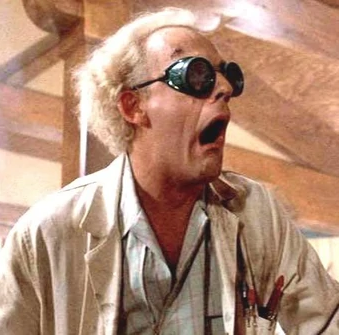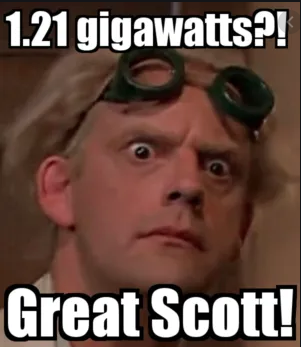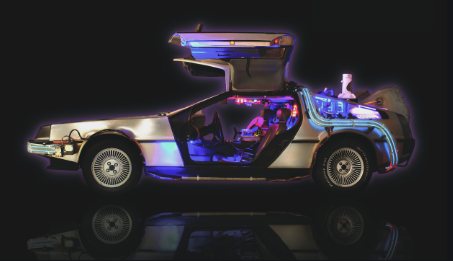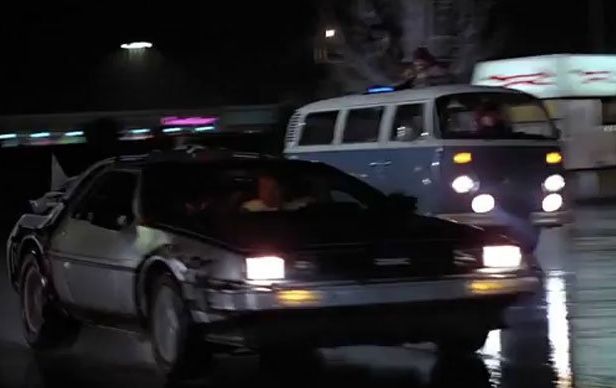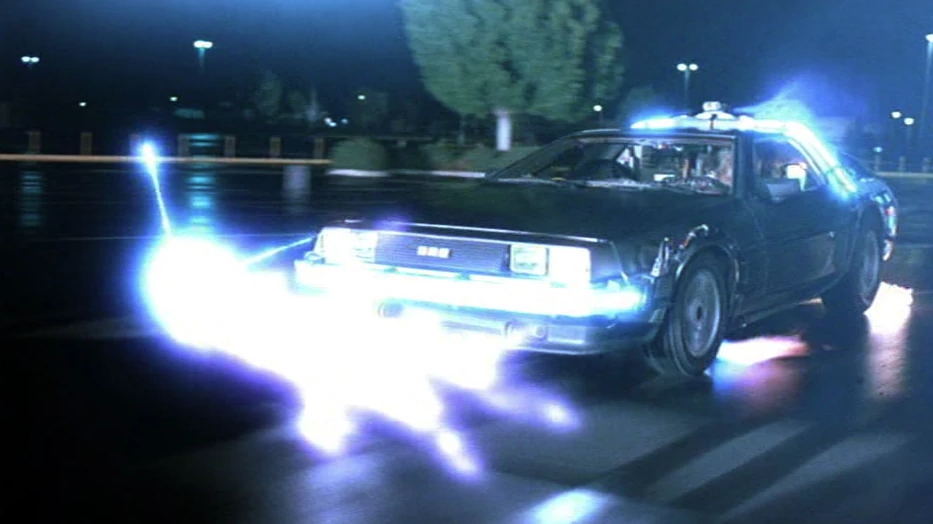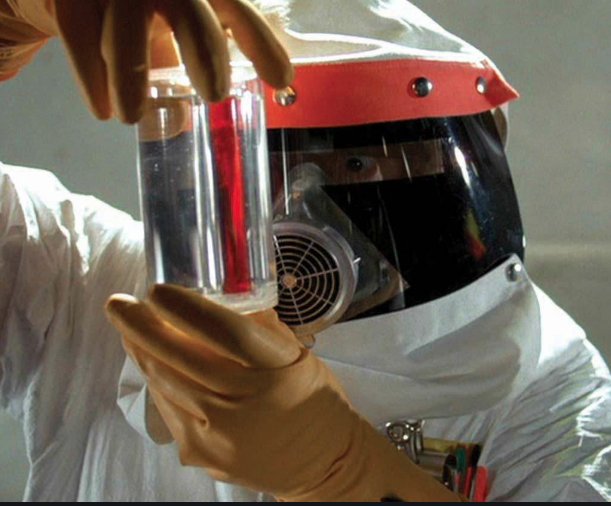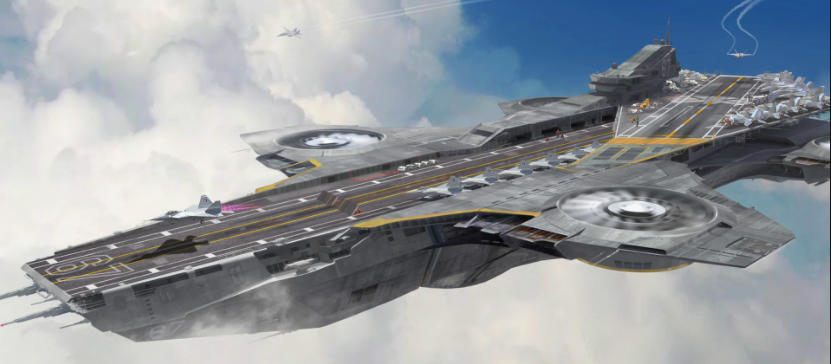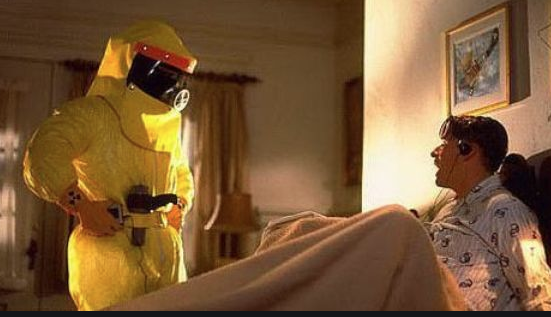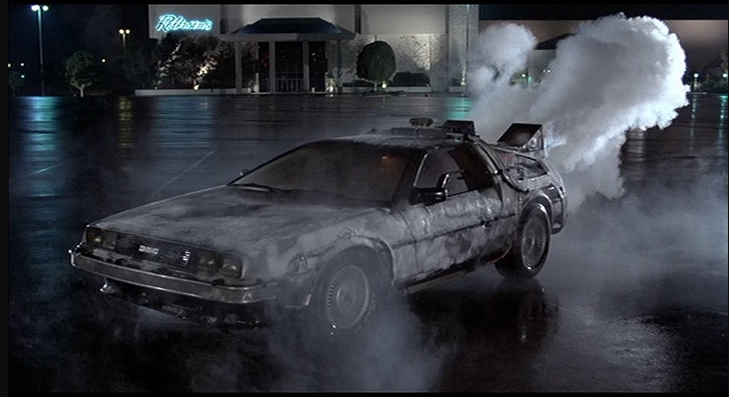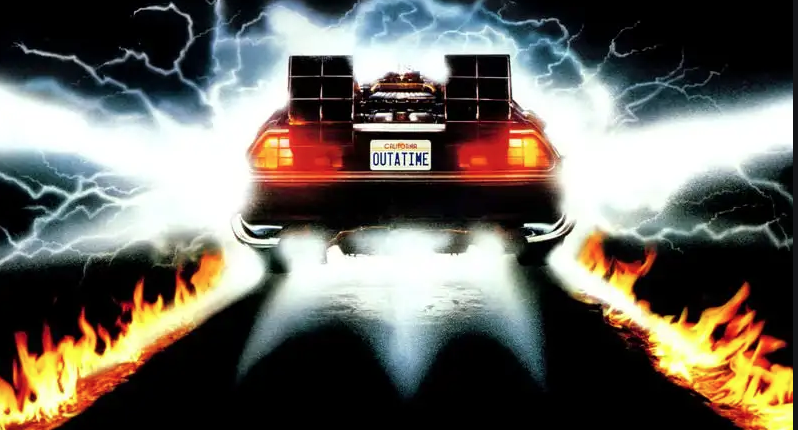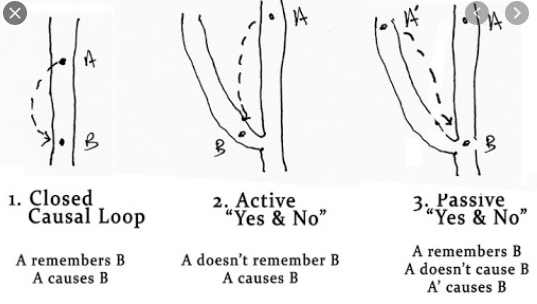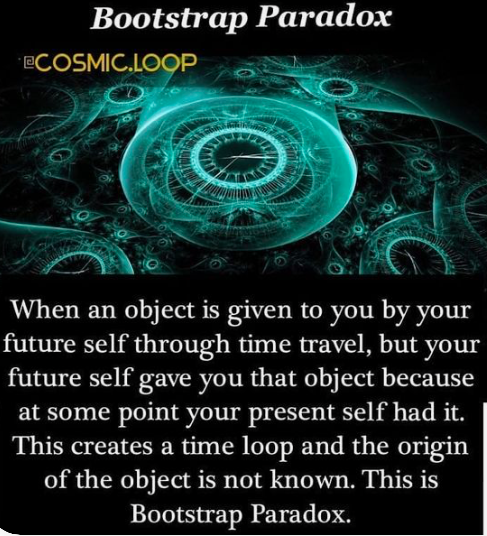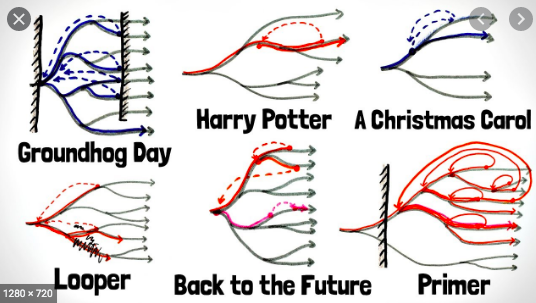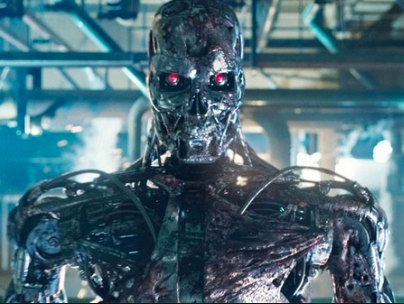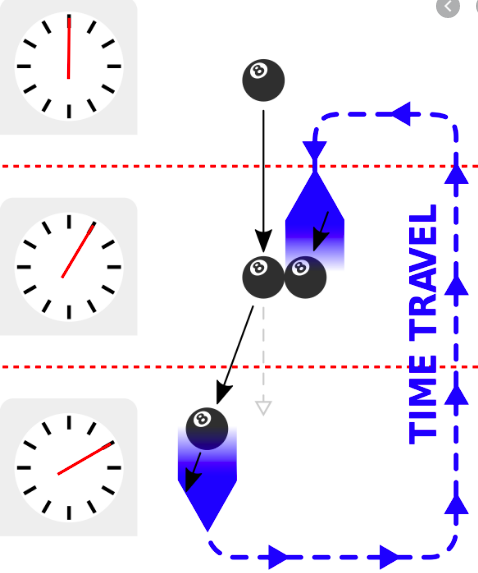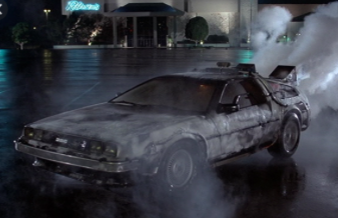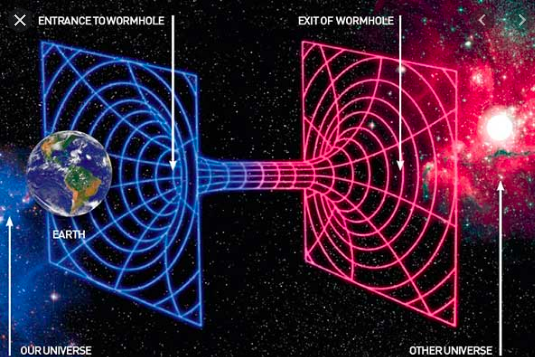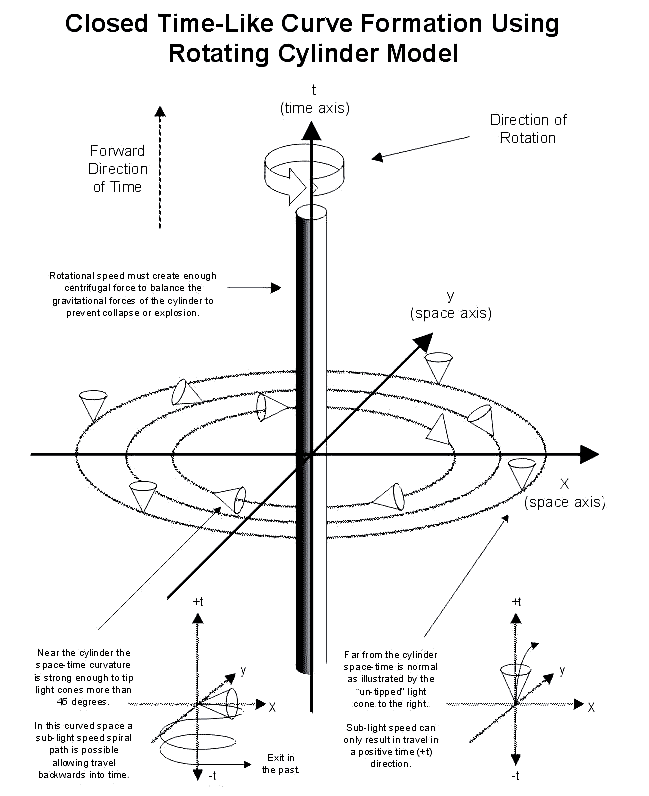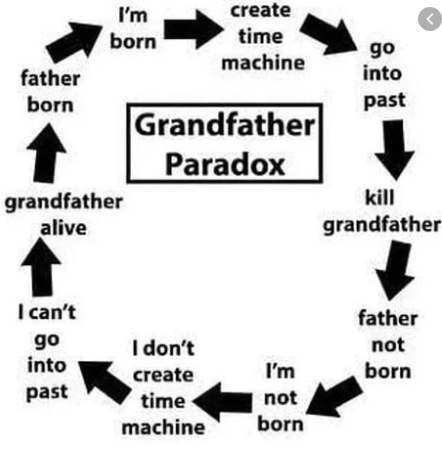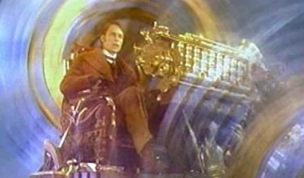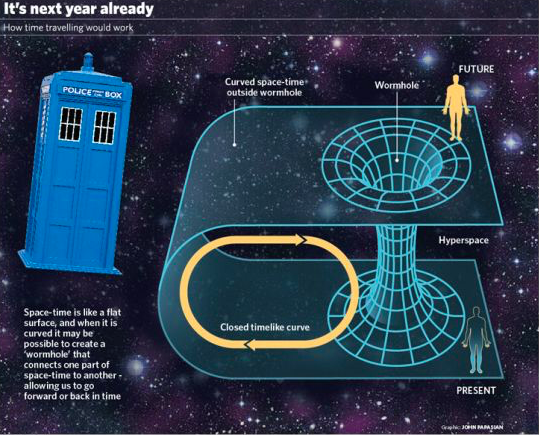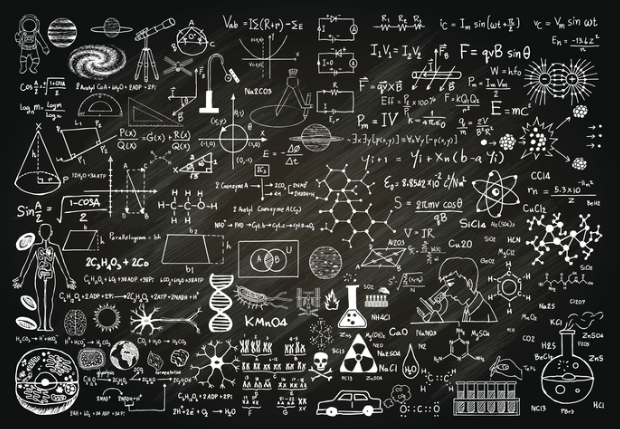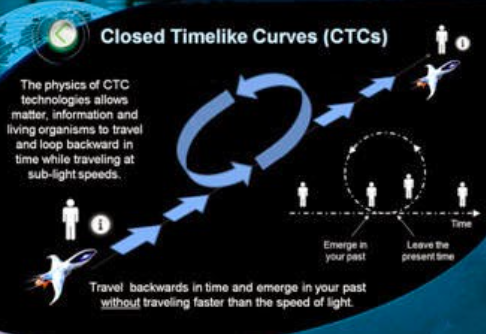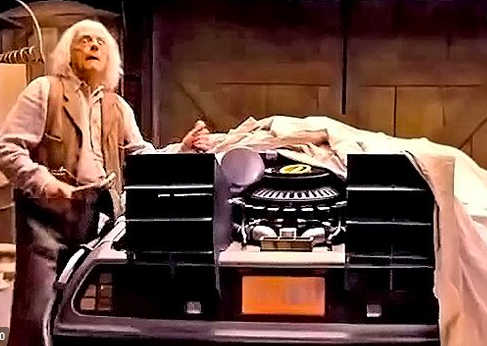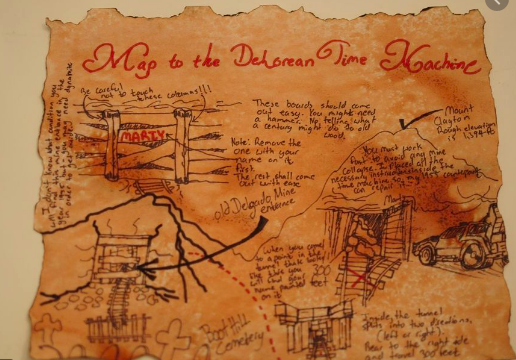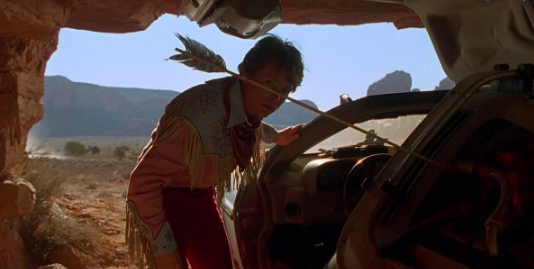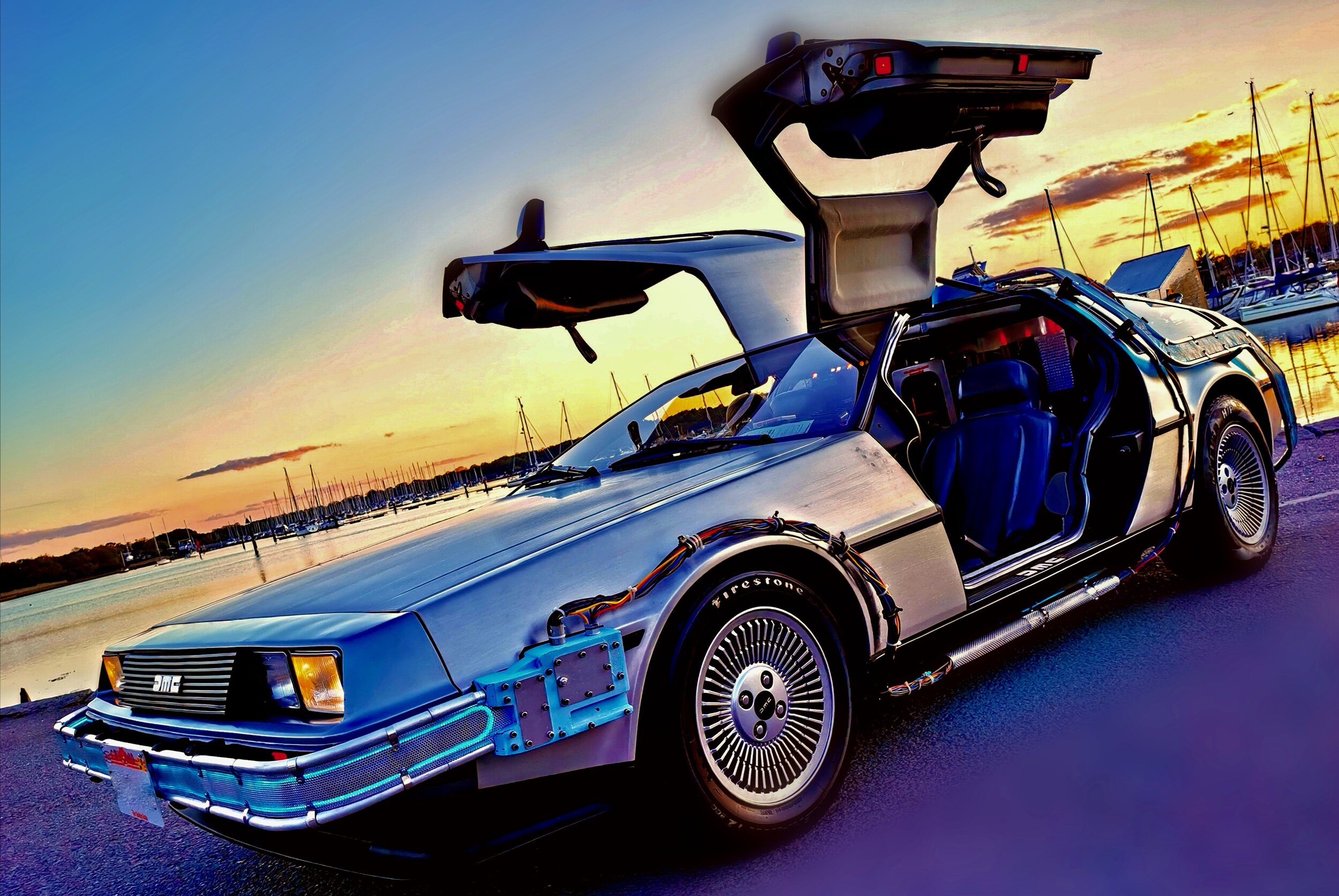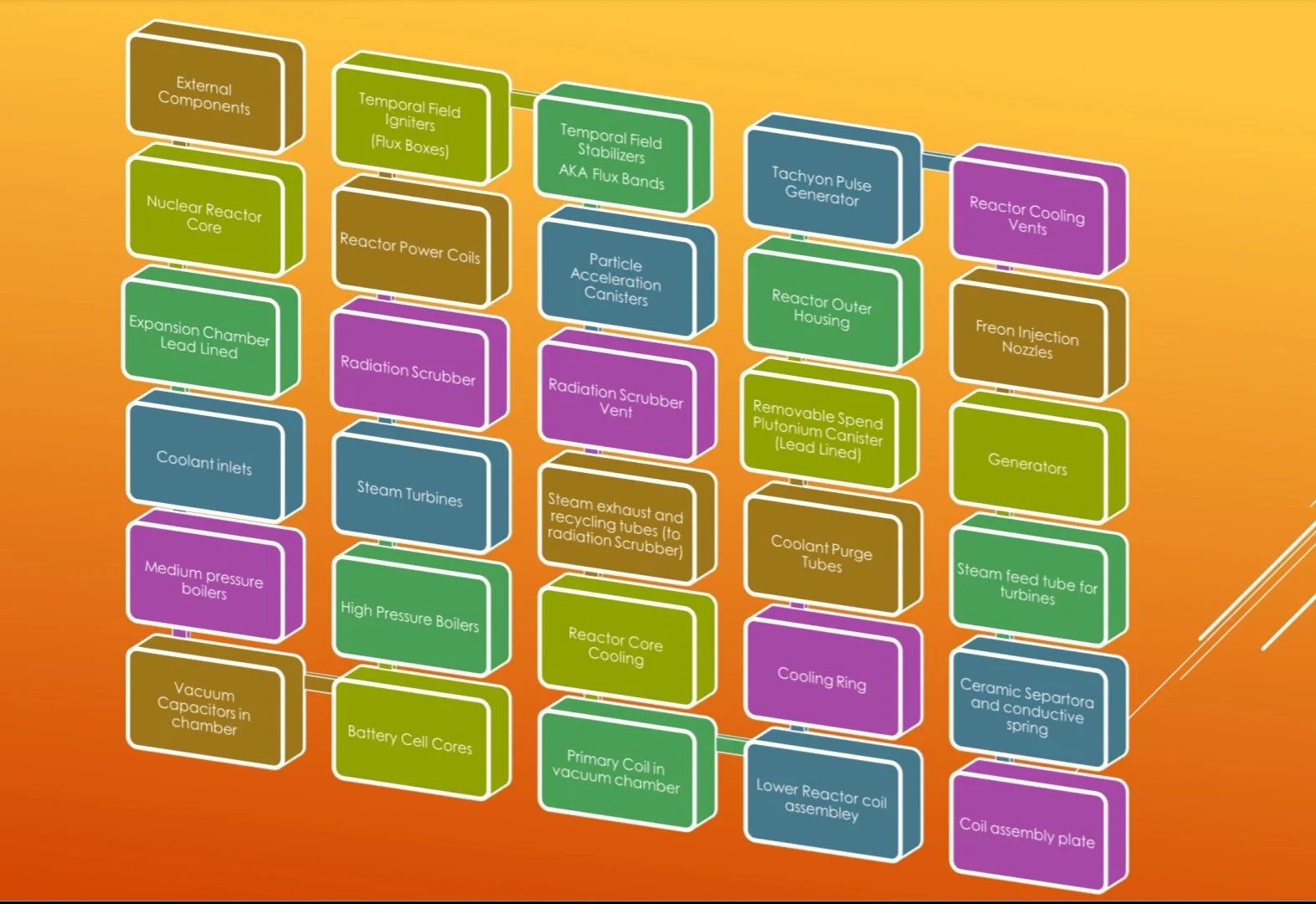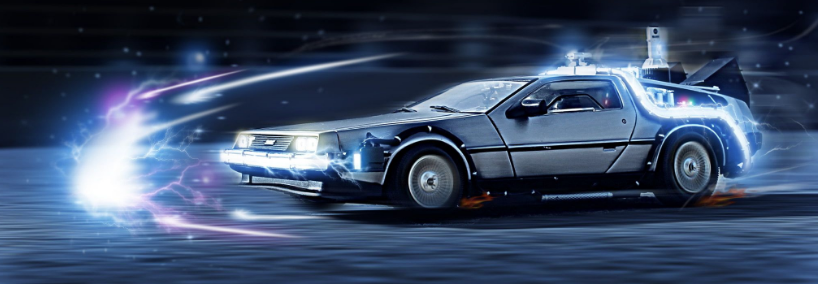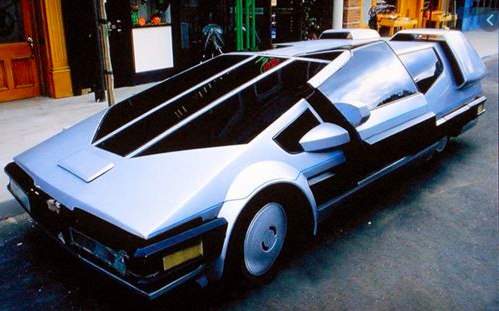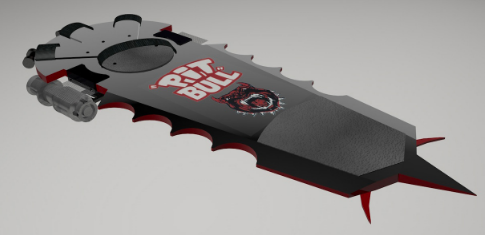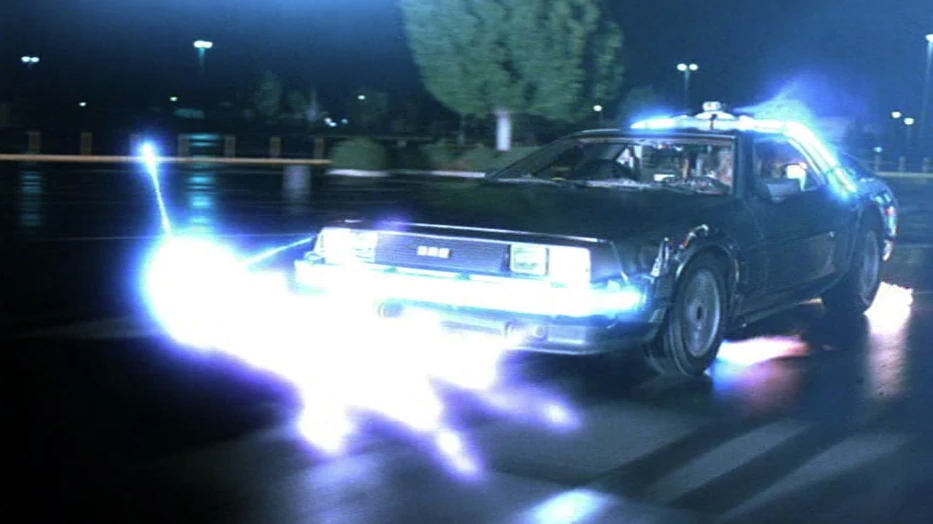
Great Scott !!! How to generate 1.21 Giggawatts (Jiggawatts) with Mr Fusion ...... in the DeLorean Time Machine
Sending you Back to the Future ! But how could Doc Brown invent, design, and build a Time Machine out of a DeLorean ? …. And could it be possible in the Future ? We explore the science behind this amazing Si/Fi Stainless Steel Car
🤯 1.21 Gigawatts: The Fictional Power of Time Travel
The phrase "1.21 Giggawatts" (often pronounced "jigowatts" in the film) is one of the most iconic pieces of fictional scientific jargon in cinema history. It represents the minimum power threshold required to activate the Flux Capacitor and initiate a temporal jump in the DeLorean Time Machine.
For your blog on "Is Time Travel Possible," this figure offers a perfect starting point for discussing the power problem of real-world theoretical physics.
What is a Gigawatt?
In real-world physics, a gigawatt (GW) is a unit of power.
The Breakdown: The prefix 'giga-' represents a factor of 109, or one billion. Therefore:
1 GW=1,000,000,000 Watts
The DeLorean's Requirement: 1.21 GW is 1.21 billion watts. This unit measures the rate at which energy is being transferred or used at a specific moment.
How Much Power is 1.21 GW, Really?
To put Doc Brown's requirement into perspective, 1.21 GW is an enormous amount of power, equivalent to the continuous output of a major electrical infrastructure:
Large Power Plants: A single, large modern nuclear or coal power plant typically produces power in the range of 1 gigawatt (GW).
Homes and Lightbulbs: 1.21 GW could power over 10 million 100-watt light bulbs simultaneously.
Vehicles: It would take the peak power output of thousands of modern sports car engines to reach this figure.
The Real-World Connection: Lightning
Doc Brown famously states that the only natural source capable of producing 1.21 GW is a bolt of lightning. This is where the film's science surprisingly aligns with reality:
MetricDeLorean RequirementReal-World Lightning BoltPower (Rate)1.21 GW (Gigawatts)A typical lightning bolt's peak power is often in the GW to TW (Terawatt, 1000 GW) range.Energy (Total)Not explicitly stated (implied to be short pulse)Total energy is relatively low (∼5 billion Joules) due to its short duration(microseconds to milliseconds).
The key takeaway is that lightning provides the necessary power pulse—the instantaneous rate of energy—to trigger the Flux Capacitor, even if the total sustained energy is not what a power plant would produce over an hour. This high-power, short-duration pulse is exactly what's needed for the fictional device to momentarily rip a hole in the space-time continuum.
The extreme power requirement of 1.21 GW serves as a brilliant cinematic shorthand for the kind of exotic energy source that theoretical physics suggests would be necessary to overcome the barriers to time travel.
We all know what Doc Brown said in the first movie.
"I need a nuclear reaction to generate the 1.21 gigawatts of electricity I need".
Doc Brown
Hill Valley Clock Tower - Lighting strike Credit : Universal Pictures Amblin Entertainment
GREAT SCOTT !!! HOW TO GENERATE 1.21 GIGGAWATTS (JIGGAWATTS) WITH MR FUSION ...... IN THE DELOREAN TIME MACHINE
Your Built a Time Machine ….. Out of a DeLorean ! ….. We explore the science behind Doc Browns amazing Time Machine, starting with what is 1.21 Gigawatts and how can you generate that kind of Power …….
Great Scott! Marty: What? What the hell is a gigawatt?
1.21 Gigawatts was pronounced (on set) as it were spelled with a "j", as in jigawatts (or jigowatts)..
So, how much is 1.21 gigawatts you ask?
Well, a gigawatt is equal to one billion (10 9) watts or 1 gigawatt = 1000 megawatts.
A watt is a unit of power.
Your typical 100 watt incandescent light bulb draws 100 watts of energy, so 1.21 gigawatts would be able to light over 12 million 100 watt light bulbs. 1.21 gigawatts is also equivalent to 1,621,400 horse power
How does the plutonium in the BTTF car generate 1.21 gigawatts in less than a couple of minuets?
Well the meaning of power (the watt is a unit of power). Power refers to the rate at which energy is produced. Power can be one of several things. The most often way to describe it is the change in energy in a certain amount of time.
1 watt = 1 joule per second where a joule is a unit of energy. Horsepower is another unit of energy where 1 hp = 746 watts.
(roughly equivalent to the amount of energy it takes to lift a medium large apple 3 feet)
If energy is measured in units of Joules, and the time interval is in seconds the power would be in Watts.
What about the giga? Giga is a prefix for units that typically means 10 to the power of 9.
This means that 1.21 gigawatts would be 1.21 x 10 to the power of 9
This means producing a given amount of power in a limited amount of time is not an important problem.
If you have a battery that can store only 1 joule of energy : but will discharge in a nanosecond the power output will be a gigawatt, but only for that nanosecond.
A large marine battery can store 8 megajoules and could theoretically produce 1.21 gigawatts for .066 seconds.
Nowhere in the movies is it stated for how long the 1.21 gigawatts needs to be produced, but we can estimate an upper limit based on the properties of lightning.
A typical bolt of lighting contains about a gigajoule of energy and lasts for .2 seconds.
The dynamics of how the lightning was used to power the flux capacitor indicates that it was directly powered by the lightning and no storage battery was involved. We can therefore deduce that the maximum energy needed to create a temporal shift is 1.21 gigajoules/sec X .2sec = 242 megajoules.
We now have two ways to power the flux capacitor:
The Flux Capacitor Credit : Universal Pictures Amblin Entertainment
1) Feed it directly from gigawatt capable generator or
2) Use a lower power generator to charge up a 242 megajoule battery.
A currently available 242 megajoule battery weighs a little over 200 pounds and is the size of a standard blue home recycling bin.
While this type of battery is not rechargeable and cannot deliver all of it’s energy in .2 seconds it gets us in the ballpark of what is needed.
On the other hand there are no gigawatt generators currently available that could fit in a container sized truck , much less a Delorean.
We therefore conclude that in standard mode the flux capacitor is battery powered for the .2 seconds or less it is in use and the plutonium generator does not need produce 1.21 gigawatts.
A micrometer-sized circulators that can be fabricated on a microchip.
We figured out how to integrate magnetic flux quanta — the smallest units of magnetic field — with microfabricated capacitors and other superconducting circuit elements, so that time-reversal symmetry can be broken.
This led to our new circulator proposal. As with conventional circulators, there is a magnetic field present. But because we can use just one magnetic flux quantum, our design can be microscopic.
See the design similarity: (left) the fictional flux capacitor from the movie and (right) a schematic representation of the proposed circulator. Tom Stace/Screenshot from Back to the Future, Author provided
We’ve nicknamed the device the quantum flux capacitor as its circuit diagram has a passing resemblance to Doc Brown’s mythical invention (which are for sale, sort of).
Sadly for history buffs, our design won’t help much in your DeLorean time machine: it doesn’t reverse time. But its magnetic field does break time-reversal symmetry as advertised and we expect these devices will find applications in future quantum technologies.
Even sooner, they may help in high-bandwidth communications environments like mobile phone base stations in very dense populations, or for ultra-high sensitivity radar where every photon of the electromagnetic field counts.
www.theconversation.com
Great Scott Doc Brown -
If we allow for a 24 hour recharge time for the battery then the generator only needs a continuous output of 2600 watts. No problem for an eccentric genius.
Paul Grimshaw - IT Architect in the Computer Industry (1983-present)
How many AA batteries would it take to generate the 1.21 gigawatts of electricity needed to send Doc Brown’s Delorean back to 1985?
Let’s see, you can squeeze around 5A at 1V out of a decent NiMH AA cell, so that’s 5W.
To get 1.21GW you would therefore require 242,000,000 cells
NiMH AA batteries weigh around 30g per cell, so 242 million of them would total 7,260 tonnes!. With cabling that’s around the weight of a modern Navy Destroyer ship.
AA batteries are 14mm diameter and 50mm long. Allowing a little room for cabling, you can squeeze 100 batteries in 1000 cubic cm (1 litre).
So for 242,000,000 cells you would need 2,420 cubic metres. That’s about the size of 10 double decker buses.
So probably not the most practical of options.
Instead, ironically, capacitors would be a much better idea for powering a flux capacitor.
The Flux Capacitor
Not just any old capacitors, but some of the capacitors capable of outputting the highest powers as listed here:
SERIES CMX - Self-Healing Energy Storage Capacitors
The 3330CMX2205 looks particularly suitable, each one capable of outputting 100,000A at 3,300V.
So just four of these could generate a colossal 1.32GW - that’s more than enough to send Doc to 1985 AND power his heated car seats at the same time.
Weighing in at 49kg each, four of these capacitors weigh a mere 196kg - let’s round up to 200kg with some mounting brackets. Spacewise, the bank of four capacitors occupy 0.66 x 0.41 x 0.56m, so these would fit comfortably in the trunk, with room for a set of golf clubs to spare.
Did anybody spot the name of the capacitor manufacturer in the link? Yep, it’s General Atomics. So it may not be Plutonium, but it’s still Atomic powered!
Just the job. To be fair, these capacitors can only output this level of power for a fraction of a millisecond, but I’m pretty certain that’s more than enough time to get back to 1985 as long as the car is going fast enough.
Also they would be ideal for recharging by lightning ready for the trip back. As you can see in the picture, they even have a convenient warning on the front not to handle the lightning whilst it’s running through the cable.
On a slightly more serious note, capacitors are commonly used to provide very high power short duration energy bursts. One example is at the US National Ignition Facility, where they have 4,000 capacitors similar to those above, in this case to power their laser.
The energy stored is again released in a fraction of a millisecond, but this time at a power exceeding 1 TeraWatt. That’s a thousand times that used by Doc, and it exceeds the peak electricity demand of the entire US.
Scott Soloway - Degree in math and physics but majored in pinball
Paul Grimshaw - IT Architect in the Computer Industry (1983-present)
The lower thrust fusion rocket produces 187.1 GW of power. Ten of these plants would power all industry on Earth.
How Do You Get 1.21 GigaWatts For Your Time Machine?
DeLorean Time Machine
Nizmitz Class Aircraft Carrier
Is that a large amount of power?
Yes. Just for comparison, the nuclear power reactors in a Nimitz Class Aircraft Carrier produces 194 megawatts (1.94 x 108 watts).
Or perhaps you would like to compare this to the flying S.H.I.E.L.D. Helicarrier. With my calculations, I get a power requirement of 317 gigawatts.
S.H.I.E.L.D Helicarrier
First look at the DeLorean Time Machine Credit : Universal Pictures Amblin Entertainment
What Does Doc Brown Even Mean?
How much power does it take to travel through time?
Well, Doc said 1.21 gigawatts.
If I want to calculate the energy required for time travel, I will need the power (given) as well as the time.
How Long Does it Take to Travel in Time?
That's actually looks like a stupid question. Oh well. Let's take a look at the actual real life footage of the time machine (from the historical archives).
Time travel is possible if you get the car up to 88 mph.
Is this car going 88 mph? Is there any way to tell? Oh, yes. Yes, there is. All I need to do is to look at this car (a DeLorean) and use – video analysis. The clip isn't perfect, but I think it will give a good enough estimate. I can scale the video using the wheel base of 2.413 meters.
Time Machine being chased by VW Camper Van in Twin Pines Mall Credit : Universal Pictures Amblin Entertainment
Here is a plot of the position of the DeLorean in the first time travel (with the dog in the car).
The slope of this line puts the car's speed at 56.7 m/s (127 mph). Yes, that is faster than 88 mph. I'm not sure why the one frame repeated. Also, there could be a problem with my scale since it was rather difficult to see the car. Here is the next time the car gets to a speed near 88 mph (when Marty first goes back in time).
DeLorean Time Machine - Flux - in Twin Pines Mall Credit : Universal Pictures Amblin Entertainment
DeLorean being struck by lighting Credit : Universal Pictures Amblin Entertainment
Well that's not good. This give a speed of 29 m/s (65 mph). For this video, the car isn't quite up to 88 mph so this seems ok. I guess I should look at the last time travel speed (when Marty goes BACK TO THE FUTURE). Oh, actually there is not a good shot to analyze there. Oh well, the second shot is close enough to 88 mph, that I will just stick with that.
What about the time interval? For the first test, I looked at the time from just when the car started to shoot sparks until it "exploded".
This gives a time of 4.3 seconds. But wait !
What about the case when a lightning bolt is used to power the car? For that case, the time machine is only getting power for at most 0.46 seconds. So, there are two different time intervals for two different trips through time.
Time Travel Energy
Now that I have the power AND the time, I can calculate the required energy. Let's just do it (for both time interval estimates).
That's not so bad. I have an energy range with the high end just a factor of 10 higher.
Now, how do you get 5 x 108 - 5 x 109 Joules?
Doc Brown's first choice was to use plutonium. Although he didn't give too much of the details, I guess he was using Plutonium-239. Pu-239 is radioactive, but I don't think that's how it gave energy in this case.
Instead, I guess that there was some type of fission process that broke the nucleus into smaller pieces. Since the pieces have less mass than the original, you also get energy (E = mc2). The Wikipedia page on plutonium as the details, but let's just say that one Plutonium atom produces 200 MeV (mega electron volts) in the fission process (3.2 x 10-11 Joules).
Doc Brown refuelling the DeLorean Time Machine Credit : Universal Pictures Amblin Entertainment
Doc Brown Plutonium Case - Credit : Universal Pictures Amblin Entertainment
In a typical nuclear reactor (which probably wouldn't use Plutonium-239), this energy is used to increase the temperature of water to make steam. The steam then turns an electric turbine to produce electricity. Clearly, that's not happening here. I'm not sure what's going on - but surely it's not a 100% efficient process. I am going to say it's 50% efficient.
In order to get 5 x 108 Joules, I would need:
Since 1 Plutonium-239 atom has a mass of 3.29 x 10-25 kg, this would require a fuel mass of just 1.2 x 10-5 kg. That seems possible.
What about a lightning bolt? Could you get this much energy from lightning? According to Wikipedia, a single bolt of lightning can have about 5 x 109 Joules. That would be just perfect for the time traveling machine.
Refuelllng the DeLorean Time Machine Credit : Universal Pictures Amblin Entertainment
Hill Valley Clock Tower being stuck by lighting Credit : Universal Pictures Amblin Entertainment
But what if lightning & Plutonium for an energy sources are just difficult to get hold of ?
Maybe batteries would be an interesting way to power this machine.
How many AA batteries would you need? From a previous post,
I already know that a high quality AA battery has about 10,000 Joules of energy. In order to get 5 x 108 Joules, I would need 5 x 104 AA batteries. Of course, that assumes that I could completely drain these batteries in just half a second. Damn, those things would get hot.
AA Batterys
Homework
Clearly, there are other questions. Here are some that I can think of.
How much space would a DeLorean need to get up to 88 mph? You can look up the time for it to get from 0-60 mph and assume that it has a constant acceleration.
At the end of Back to the Future, Doc Brown replaces the Plutonium energy source with a Mr. Fusion. Estimate how much energy he could get from a banana peel.
Mr Fusion Fuel Credit : Universal Pictures Amblin Entertainment
· If you watch all three movies in the Back to the Future series, there are several times that the car gets up to 88 mph. Use video analysis to check the speeds.
·
How long would it take current from the lightning strike to travel from the clock tower to the car?
·
Suppose that Marty is 1 second late on his start to get to the lightning wire. How much greater of an acceleration would he need to make it to the wire on time (assuming that over 88 mph works just as well as 88 mph)?
·
What if there wasn't a known source of lightning? What other ways could Doc get energy to power the DeLorean in 1955 (or whatever the year was)?
·
Assume that the energy needed to time travel was directly proportional to the mass of the object. Would the S.H.I.E.L.D. Helicarrier have enough power to go back to 1957?
Pushing the DeLorean to 88mph Credit : Universal Pictures Amblin Entertainment
S.H.I.E.L.D - Helicarrier
Carmen Drahl Former Contributor Science
Wheres Mr Fusion ?
To get some answers, I spoke with Egemen Kolemen. He’s a specialist in the control of fusion plasmas at Princeton University, where he is an assistant professor with joint appointments at the Andlinger Center for Energy and the Environment, the department of mechanical and aerospace engineering, and the Princeton Plasma Physics Laboratory.
Egemen Kolemen, Princeton University (Credit:
Our Q&A is below, and is lightly edited for clarity.
Carmen Drahl:
Thanks for talking futuristic fusion with me, Dr. Kolemen!
In Back to the Future, the central time travel device was originally powered by plutonium, but this was replaced by the Mr. Fusion reactor.
Mr Fusion Home Energy Reactor Credit : Universal Pictures Amblin Entertainment
What’s the difference between how radioactive plutonium might generate electricity and how a fusion reactor would?
Egemen Kolemen: Radioactive plutonium produces energy by splitting up to smaller elements, which is known as the fission reaction.
In a fusion reactor, we combine small nuclei to make energy. Soon enough, we hope to move from fission to fusion technology just as Back to the Future II predicted.
This would help Doc Brown avoid troubles with the terrorists in the original movie— we use water as fusion fuel and you cannot make an atomic bomb with water!
CD: Mr. Fusion was able to generate power from household garbage— a banana peel, Miller beer, and even a beer can! What are the typical starting materials that are used in fusion reactors today?
EK: We use isotopes of the element hydrogen (known as deuterium and tritium) in current fusion reactors. There is enough heavy hydrogen fuel in sea water, H2O, to fuel the world’s energy needs for billions of years.
CD: In theory, could Mr. Fusion have been generating power by fusing together several different atoms or isotopes contained inside the garbage?
Mr Fusion ReFuelling
Or could the reactor only work by fusing deuterium and tritium in the garbage? In other words— could you generate energy from fusing many different nuclei?
EK: Theoretically, fusing elements lighter than iron releases nuclear energy. If a clever physicist could overcome the engineering problems, a machine like Mr. Fusion could physically make energy by fusing banana or beer which mostly consists of carbon, oxygen and hydrogen. (It would even work for a beer can made of aluminum!). This is the process that happens in the core of large stars which is the birthplace of all the heavy elements in the universe.
Time Machine refuelled
However, as the elements get heavier, the fusion process gets harder and requires more energy to initialize and becomes less economical. That is why we use the isotopes of hydrogen, the lightest element in the universe.
Mr Fusion
There is no physics reason why you could not fuse many different nuclei.
Stars fuse many different elements with each other.
However, just as cars are designed to run with only one specific type of fuel (gasoline, diesel, etc.) to make them more efficient and economical, fusion reactors that work on preset fuels would be cheaper and an easier engineering challenge.
CD: Mr. Fusion was the size of a coffee maker.
That’s pretty tiny compared to the typical fusion reactor—
the experimental reactor being built in France will be over 5000 tons!
What are the challenges to making fusion reactors small?
EK: The fusion process happens when two particles hit each other each other at high velocity inside the reactor.
So, the energy production in a fusion reactor grows roughly in proportion to the volume (or the number of particles inside) of the reactor.
At the same time, the energy loss occurs mostly due to the drifting particles out from the surface of the reactor. As the reactor size gets bigger, volume which grows roughly as the cube of the radius increases much faster than the surface which grows as the square of the radius.
As a fusion reactor gets bigger the ratio of energy production to losses increases making it easier to produce net energy.
We use very strong magnetic forces to be able to confine the deuterium, tritium and electrons inside the reactor. If one can build superconducting coils that can produce much stronger magnetic fields (i.e. a stronger trap) than the ones available today, a smaller machine might be possible. This is an active research topic!
Interior of the National Spherical Torus[+]
CD: We’ve all seen car engines malfunction. Could Mr. Fusion explode in a mushroom cloud destroying everything in a 250 mile radius if something went wrong?
EK: Fusion is a delicate process that needs constant control. Unlike fission reactors, fusion cannot have a runaway chain reaction. If the “engine” malfunctions, the fusion process would stop immediately. So no explosion is possible. That is one of the many advantages of fusion energy.
CD: Mr. Fusion would have to be doing hot fusion, because cold fusion is a myth, right?
EK: There is no scientifically known net energy-producing cold fusion reaction.
CD: So since you do have to heat your starting materials to extremely high temperatures to achieve fusion, how cool can we make the outside of a fusion reactor—cool enough to safely attach to a vehicle?
EK: The wall inside the fusion vessel would be hot just as the inside of the car engine. However, the reactor would have a cooling system, similar to the radiator in a car, making the outside of the reactor at room temperature. The reactor would be as safe as the car engine.
CD: We still haven’t passed the break-even energy point in nuclear fusion— where we get more energy out of fusion than we had to put in. What gives you reason to think we’ll get there?
EK: We have been running experiments on many different fusion reactors all around the world and comparing the experimental data we obtain to computed simulations of the physics process.
We have been upgrading our simulation capabilities using new numerical methods and tools and checking against the experimental data.
At this point, we can reproduce and predict experimental outcomes in existing fusion reactors. We believe that our understanding of the physics and capability to simulate processes are advanced enough to roughly predict how a reactor will behave.
Based on this understanding, we designed the ITER (International Thermonuclear Experimental Reactor) nuclear fusion reactor. ITER is under construction under an international collaboration, and it is expected to come online in a decade.
We predict that we will obtain 10 times more fusion energy output as the power we put in. As with any research, we can only know the exact answer after running the machine but we try to do our best to predict the reactor behavior.
CD: Thank you for your time, Dr. Kolemen!
Follow me on Twitter.
I'm an independent journalist specializing in chemistry, in particular the places where chemistry meets biology. I was a staff science writer at Chemical & Engineering…Read More
As a renewable energy source, cold fusion is potentially unlimited clean energy. But what is fusion energy, how does it work, and is there such a thing as cold fusion?
You may have heard about cold fusion, the idea that atoms can be fused together without using any significant heat or other type of energy and yet producing a great deal of energy.
This philosopher’s stone has been the object of the quest of many a modern-day alchemist, so we shall leave it to them.
Hot fusion, however, is real. It’s what happens inside the sun and other stars. Nuclei of atoms crash into each other at great speed, resulting in fusion and a great deal more energy released. Research and development into fusion energy is trying to create similar reactions here on Earth at over 100 million degrees Celsius.
The opposite of nuclear fission
Fusion energy, in a way, is the opposite of what we conventionally call nuclear energy – although fusion energy also deals with the nucleus of atoms. In current nuclear power plants, the energy comes from splitting the atom.
Fusion, as the name suggests, produces energy not by breaking atoms apart, but by fusing them together.
The real difference comes from the kind of elements involved in these processes. What we know as nuclear energy requires elements with big, heavy atoms like uranium or plutonium that can be split into smaller atoms.
However, uranium, plutonium, and their fission products are radioactive, which means that when they decay they emit ionising radiation, which in certain circumstances might be dangerous to humans.
Back to the Future Darth Vader Credit : Universal Pictures Amblin Entertainment
Fusion energy instead is based on combining two lightweight atoms – usually hydrogen. When two hydrogen atoms fuse, they create helium.
So not only does fusion energy rely on the most abundant element in the universe, its byproduct can be easily used for medical purposes, or to blow up balloons.
Try pushing two magnets together
How do you fuse two atoms?
The challenge comes from the fact that the nucleus of an atom contains positively charged protons and neutral neutrons, as you will surely recall from your physics class.
Therefore, the nucleus of an atom will always carry a positive charge. Trying to combine it with another one with a positive charge is like trying to push two magnets towards each other. They will resist. This is why fusion energy uses the lightest atoms possible. But it is still very hard.
Inside the sun, fusion occurs because the immense gravity draws atoms together, creating extreme density and enormous heat, which makes the atoms collide with each other at great speed.
The force of gravity is much weaker on Earth, because of the relatively small size of this planet, and the temperature – despite global warming – is nowhere close to the heat of the sun. So how can we create similar conditions here for fusion to occur?
Hotter than the sun
The answer is fairly obvious. To make up for our lower gravity, you simply have to create a temperature hotter than the sun.
Six to ten times hotter, up to 150 million degrees Celsius. Here on Earth this tremendous heat will create the conditions to allow the hydrogen atoms to bump into each other, resulting in fusion and generating even more energy.
Sounds easy? There are quite a few details that need to be ironed out.
First issue: where could you create such a temperature, so that the heated substance wouldn’t destroy everything it touches?
Again, the solution is simple: don’t allow it to come into contact with anything. To achieve this, Russian scientists in the middle of the 20th century developed the tokamak, a chamber the shape of a hollow doughnut, surrounded by powerful magnets.
Inside this chamber, the hydrogen gas is heated to an extremely high temperature and transformed into a plasma state.
The plasma state is one of the four fundamental states of matter, in which the gaseous substance becomes ionised – because electrons orbiting the atomic nuclei are stripped away.
The ionised matter is electrically conductive and therefore the magnetic fields can dominate the behaviour of the matter. That is where the magnets come in.
Magnets can keep this electrically conductive substance from approaching the tokamak’s walls, hovering above it. Inside the plasma, the conditions are suitable for the atoms to bump into each other and to fuse, releasing energy.
The world’s largest experimental tokamak nuclear fusion reactor – called ITER – is under construction in France, to prove the feasibility of thermonuclear fusion as a large-scale and carbon-free source of energy.
ITER is an international research and engineering megaproject involving the European Union, China, India, Japan, South Korea, Russia and the US.
If successful, the facility will turn 50 MW of power inserted into the system – to initially heat the plasma – into fusion power output of 500 MW.
A lot of doughnut
The ITER reactor will be huge:
the ITER tokamak will be as heavy as three Eiffel Towers;
the structure of the 1 000-tonne electromagnet in the centre of the machine must be strong enough to contain a force equivalent to twice the thrust of the Space Shuttle at take-off (60 meganewtons, or over 6 000 tonnes of force);
there will be 18 D-shaped electromagnets around the doughnut-shaped tokamak chamber, each of them 17 metres high and 9 metres wide, weighing 310 tonnes, the approximate weight of a fully loaded Boeing 747-300 aeroplane.
270 million degrees Fahrenheit to ignite fusion—a full ten times hotter than the sun's core.
But how could we get that enormous energy out of the doughnut and safely channel it into our homes as electricity?
This is done via the main chamber wall and a region called the divertor, positioned at the bottom of the tokamak. The divertor controls the exhaust of heat, waste gas and impurities from the reactor and withstands the highest surface heat loads. The surface of the divertor is covered by tungsten, the metal with the highest melting point (3422°C).
In 2019, with the backing of the European Fund for Strategic Investments, the European Investment Bank signed a €250 million loan to the Italian research agency ENEA to help build the divertor and tokamak test facility. The plant will test various alternatives to exhaust the huge amount of heat flowing into the divertor component of a nuclear fusion reactor.
A glorified steam turbine
Researchers continue to look for alternatives, but as it stands now the whole process of transitioning the heat to electric power then becomes rather old-fashioned.
The heat received by the plasma-facing wall and the divertor will be used to turn water into steam, which will drive a steam turbine. divertor, positioned at the bottom of the tokamak“The scientific advances towards fusion energy are not likely to occur like the apple falling on Newton’s head,” says Istvan Szabo, a senior engineer in the European Investment Bank’s energy security division. “You need many more resources.”
Szabo concedes it is possible that tomorrow someone will come up with a completely different solution to harness fusion energy, or a different answer to the need for sustainable energy to power us into the future.
“There are other ideas to compress matter and fuse atoms. For example to use lasers or mechanical compression. And maybe someone will one day solve cold fusion,” Szabo says. “But testing these will all require immense resources.
Thermonuclear fusion is furthest along the research and development phase. It offers the most hope.”
Cold fusion remains elusive—but these scientists may revive the quest
The first public results from a Google-funded project reveal renewed interest in the long-sought but controversial nuclear energy source.
BY MICHAEL GRESHKO
PUBLISHED MAY 29, 2019
Sparking a controversy
Nuclear fusion occurs when pairs of light nuclei fuse together to form a nucleus of net lighter mass, releasing huge amounts of energy as described by Einstein's iconic equation E = mc2.
Inside the sun, hydrogen atoms fuse to produce helium and energy. If successfully harnessed on Earth, fusion could provide humankind with abundant, emissions-free energy—a huge boon to efforts to combat climate change. (As a byproduct, fusion on Earth might also help to address a global helium shortage.)
But getting fusion to work on Earth is tricky, since it's hard to get two nuclei close enough to combine; atomic nuclei are positively charged, so they fiercely repel one another, a hurdle known as the Coulomb barrier.
Crossing this barrier and realizing fusion power is possible at high densities and temperatures, if the nuclei are confined for a sufficiently long time. But to achieve these conditions, scientists seem to need large, expensive machines and huge amounts of initial power.
“What nature does with the enormous force of gravity in the sun's core is what mankind has been trying to do under controlled conditions in the laboratory,” says physicist Amitava Bhattacharjee, the head theorist at the Princeton Plasma Physics Laboratory, one of the leading fusion research groups in the U.S.
“For the last 60 years we’ve been at this, and I think the progress has been enormous,” he adds. “But we still continue to have a challenge to make nuclear fusion power inexpensively available to people.”
But what if cleverly structured materials could somehow lower the energy needed for fusion? That's what chemists Martin Fleischmann and Stanley Pons at the University of Utah thought they had achieved.
On March 23, 1989, University of Utah chemists Martin Fleischmann and Stanley Pons announced their "cold fusion" device to the world—sparking a scientific firestorm.
But for many, excitement quickly gave way to skepticism. Early outside attempts to replicate the results didn't turn up massive amounts of heat, nor did the setup appear to yield many high-energy neutrons, a signature of conventional nuclear fusion.
“In March 1989, everybody jumped on this topic, even serious fusion physicists (like me),” Hans-Stephan Bosch, the head of the Wendelstein 7-X fusion experiment at the Max Planck Institute for Plasma Physics, writes in an email.
“However, we didn’t find any positive result confirming their claims. Therefore we finished our work, published it, and closed the topic. My impression is that most physicists and chemists did the same, regarding cold fusion as an 'interesting' episode.”
Ever since, cold fusion largely served as a parable on the perils of irreproducibility. But a small group of researchers and enthusiasts has remained convinced that the phenomenon is real and nuclear in nature, though not necessarily the same thing as fusion.
This scientific circle still does experiments and reports its results in its own meetings and journals, though it has shed the “cold fusion” name for low-energy nuclear reactions, or LENR
Small modular reactors (SMRs) are a type of nuclear fission reactor which are smaller than conventional reactors.
This allows them to be manufactured at a plant and brought to a site to be assembled. Modular reactors allow for less on-site construction, increased containment efficiency, and enhanced safety due to passive nuclear safety features.[1]
SMRs have been proposed as a way to bypass financial and safety barriers that have plagued conventional nuclear reactors.[1][2]
Several designs exist for SMR, ranging from scaled down versions of existing nuclear reactor designs, to entirely new generation IV designs.
Both thermal-neutron reactors and fast-neutron reactors have been proposed, as well as molten salt and gas cooled reactor models.[3]
A main hindrance to the commercial application of SMRs as of 2015 is licensing, since current regulatory regimes are adapted to conventional nuclear power plants and have not been adapted to SMRs in terms of staffing, security etc.[4] Time, cost and risk of the licensing process are critical elements for the construction of SMRs.[5]
Some larger SMRs require more significant on-site construction, such as the 440 MWe 3-loop Rolls-Royce SMR, which targets a 500-day construction time.[9]
SMRs are particularly useful in remote locations where there is usually a deficiency of trained workers and a higher cost of shipping. Containment is more efficient, and proliferation concerns could be lowered.[10] SMRs are also more flexible in that they do not necessarily need to be hooked into a large power grid, and can generally be attached to other modules to provide increased power supplies if necessary.
Companies that are planning new nuclear units are currently indicating that the total costs (including escalation and financing costs) will be in the range of $5,500/kW to $8,100/kW or between $6 billion and $9 billion for each 1,100 MW plant.
The smallest nuclear reactor in operation today isn't from some startup or a cutting-edge nuclear agency: It's tiny, frozen Bilibino Nuclear Plant in Chukotka, Russia, where up to four different 12 MWe modular reactors have run since 1974.16 Dec 2019
Is it legal to own a nuclear reactor?
While they might un-nerve the neighbours, fusion reactors of this kind are perfectly legal in the US
Back to the Future Time Machine
Doc Brown The Flux Capacitor
Other questions are :
How can we generate 1.21 Gigawatts in real life, now that we're 20 years ahead of Doc Brown?
Was a bolt of lightning really the only way to produce 1.21 gigawatts back in 1955?
How can we generate 1.21 Gigawatts in real life, now that we're 20 years ahead of Doc Brown?
Was a bolt of lightning really the only way to produce 1.21 gigawatts back in 1955?
Follow our Hashtags …..
#backtothefuture #martymcfly #delorean #bttf #s #docbrown #michaeljfox #dmc #deloreantimemachine #timemachine #christopherlloyd #fluxcapacitor #hillvalley #outatime #timetravel #mcfly #movie #hoverboard #movies #deloreandmc #greatscott #backintime #art #backtothefuturetrilogy #bifftannen #bhfyp #timemachine #mcfly #marty #docbrown #greatscott #fluxcapacitor #christopherlloyd #backtothefuture2 #backtothefuture1 #backtothefuture3 #dmc12 #deloreantimemachine #deloreandmc12 #BTTF #bttf1 #bttf2 #bttf3 #time #timecircuits #docbrown #1980s #popculture #props #flux #fluxbands #glow #giggawatts #jiggawatts #1.21 #power #mrfusion #howtogenerate1.21
To find out more fun Future Facts by clicking our Blogs below……….!!! Please Share …..
Ghostbuster - Ecto 1
https://www.sandstoneproductions.co.uk/blogtothefuture/2021/3/31/ghostbusters-ecto-1
Cars of Back to the Future
https://www.sandstoneproductions.co.uk/blogtothefuture/2021/2/10/the-cars-of-back-to-the-future-55-
Back to the Future Fashion
https://www.sandstoneproductions.co.uk/blogtothefuture/2021/2/19/back-to-the-future-fashion-te2yx
Ariel Leader
https://www.sandstoneproductions.co.uk/blogtothefuture/2021/2/17/ariel-leader
Back to the Future - Hill Valley History
https://www.sandstoneproductions.co.uk/blogtothefuture/2021/2/2/hill-valley-history-jxrr4
Back to the Future Gadgets and Trends we have in 2021
Doc Browns Biography and the History of his DeLorean Time Machine
Marty McFly Biography also featuring Biff, George, Jennifer, Loranine
Back to the Future - Hill Valley History
https://www.sandstoneproductions.co.uk/blogtothefuture/2021/2/2/hill-valley-history
Back to the Future - Detailed storyline
Back to the Future - How to generate 1.21 Giggawatts / Jiggawatts with Mr Fusion
What is a Fat Bike ? And where did the idea of Fat Bikes come from ?
https://www.sandstoneproductions.co.uk/blogtothefuture/2021/1/10/fat-bike-what-is-a-fat-bike-history
The Time Paradox explained - Back to the Future
The Sinclair C5
https://www.sandstoneproductions.co.uk/blogtothefuture/2021/1/9/sinclair-c5-
Mini Jeep Mini Review
https://www.sandstoneproductions.co.uk/blogtothefuture/minicoolsterjeepreview
Hoverboards - Back to the Future
https://www.sandstoneproductions.co.uk/blogtothefuture/2020/12/13/hoverboards-
How does the Time Machine work - Back to the Future
https://www.sandstoneproductions.co.uk/blogtothefuture/2020/11/22/how-does-the-time-machine-work
The DeLorean Motor Company - What did it fail ? Or did it ?
https://www.sandstoneproductions.co.uk/blogtothefuture/2020/11/22/whydiddeloreanmotorcompanyfail
The DeLorean Motor Company - History
https://www.sandstoneproductions.co.uk/blogtothefuture/2020/11/22/deloreanmotorcompany
The Flux Capacitor - Back to the Future
https://www.sandstoneproductions.co.uk/blogtothefuture/fluxcapacitor
Is Time Travel Possible ? And what would it take ? Back to the Future
https://www.sandstoneproductions.co.uk/blogtothefuture/istimetravelpossible
Time Paradox Explained - Back to the Future
Great Scott !!! We feature Doc Brown’s Time Travelling DeLorean in our Blog about one of the wonders of Time Travel the Time Paradox. What is a Time Paradox - How does it relate to Time Travel and we discuss the science involved.
⏳ Blog Post: Great Scott! The Paradox That Could Unravel the Universe! 🤯
Headline: The Vanishing Act: How Marty McFly Almost Erased Himself with the Grandfather Paradox
The DeLorean Time Machine and the Flux Capacitor are what let us travel through time, but it's the Time Paradoxthat gives the Back to the Future trilogy its heart-pounding tension!
It's not just a cool sci-fi concept; it's the central problem that Marty McFly must fix, and it's the reason Doc Brown is so adamant about one rule: "Do not, under any circumstances, interact with anybody... from your own time."
Understanding the Grandfather Paradox
In the first film, Marty accidentally creates the most famous paradox of all: the Grandfather Paradox.
Paradox TypeThe Core ConceptHow it Applies to Marty McFlyGrandfather ParadoxIf you travel back and prevent your own ancestors from meeting (or existing), then you can't be born. If you're not born, you can't go back in time to prevent them from meeting. This creates an infinite, self-contradictory loop.Marty accidentally prevents his parents, George and Lorraine, from having their first meeting. If they don't fall in love, they don't have children—meaning Marty and his siblings would never be born.The Fading PhotoThe physical manifestation of this paradox is the iconic photograph of Marty and his siblings. As Marty's interference threatens his existence, his siblings begin to fade away from the photo one by one. This is the ticking clock that pushes Marty to fix the timeline before he's erased forever.
Export to Sheets
The "Changeable" Timeline Model
The Back to the Future universe operates on a changeable timeline model, often called the "ripple effect" theory.
Original Timeline (A): The history Marty left, where George is a pushover and Lorraine is unhappy.
Interference (1955): Marty's presence in 1955, especially saving George from the car instead of George's father, changes the cause of their parents' meeting.
New Timeline (B): Marty successfully gets his parents to fall in love and returns to 1985, which is now a vastlyimproved reality. George is a successful, confident author; Lorraine is happy; and Biff is a subservient car washer.
In this model, the past is not fixed. Small changes—like inspiring Goldie Wilson to run for mayor or helping George gain confidence—send a "ripple" through time, which quickly changes the future.
The Paradox of the Paradox
While the film is famous for the Grandfather Paradox, it also subtly includes the Bootstrap Paradox (or Ontological Paradox).
The Problem: The Bootstrap Paradox occurs when an object or piece of information has no original creator—it exists because it was passed back in time to be created in the first place.
Examples in the Film:
"Johnny B. Goode": Marty plays the song on stage in 1955, and Marvin Berry hears it and calls his cousin, Chuck Berry, telling him he's found the "new sound" Chuck has been looking for. This implies Marty, from the future, is the original source of the song in the past. If the song came from the future, who wrote it in the first place?
The Sports Almanac: In Part II, Old Biff gives the Almanac to his younger self in 1955. This piece of information (future sports results) has no point of origin in the altered timeline—it only exists because it was brought back from the future.
The paradoxes in the Back to the Future trilogy are what make it a brilliant piece of sci-fi: they are the high-stakes threat that makes Doc's frantic warnings about the space-time continuum so utterly memorable.
Time Paradox
“Doc: “I foresee two possibilities. One, seeing herself thirty years in the future would put Jennifer into shock and she’d simply pass out. Or two, the encounter could create a time paradox. The results of which could cause a chain reaction that would unravel the very fabric of the space-time continuum and destroy the entire universe!... Granted, that’s the worst-case scenario. The destruction however might be limited merely to our own galaxy.”
Marty: “Well that’s a relief!”
— Doc and Marty discussing the implications of 1985 Jennifer running into her 2015 self.
A paradox, in time travel, is “a situation in which the effect of an incident contradicts or eliminates the cause of that same incident”.[1]
”
Time travel paradox Explained
The Earth rotates around the sun - the sun rotates around the galaxy - the galaxy moves in the universe. All that being said, if the time machine were possible, the DeLorean would be in a different place, and not the same place each time it moves into the past or future.
Solar System
Here’s one possible answer: The time machine is still affected by the gravitation pull of a body such as that on Earth.
Expounding upon that: Views from inside the time machine indicate that the DeLorean time machine is traveling through a portal that only opens when the machine reaches 88 miles per hour.
Since time travel hasn't been witnessed, it's plausible that the unopened time portals are held in place by the Earth's gravity or by a physical force not yet proven. The ideas behind the first paragraph, about Earth's movement in space, have been discussed in the article about spatial displacement.
DeLorean Time Travel
Behind the scenes
The word "paradox" is often used to describe a mystery or an unanswered question. eg :
Paradox was also the title of the musical score played during the scene in Part II in which the time-traveling Doc Brown talked with his younger self while handing himself a wrench to attach the electrical cable to the lamppost in 1955; since Doc Brown caused a "pair o' Docs" to occur.
Doc Brown
Though many paradoxes arise in the trilogy, Doc may be overzealous about them because, though the effects obviously happen, the risk of destroying the space-time continuum may not really exist, mearly being a fabrication of Doc's mind to give reason to fix time-lines.
Evidence of such exists, because 1985 Doc was willing to correct 1955 Doc with the wrench size and give him the suggestion that he was conducting a weather experiment as well as telling him there was going to be a storm. He also gave 1955 Doc information on how to repair the DeLorean, via the letter, while he was stuck in 1885, knowing the risks.
There is nothing in Einstein’s theories of relativity to rule out time travel, although the very notion of traveling to the past violates one of the most fundamental premises of physics, that of causality.
With the laws of cause and effect out the window, there naturally arises a number of inconsistencies associated with time travel, and listed here are some of those paradoxes which have given both scientist and time travel movie buffs alike more than a few sleepless nights over the years.
The time travel paradoxes which follow fall into two broad categories:
1) Closed Causal Loops, such as the Predestination Paradox and the Bootstrap Paradox, which involve a self-existing time loop in which cause and effect run in a repeating circle, but is also internally consistent with the timeline’s history.
2) Consistency Paradoxes, such as the Grandfather Paradox and other similar variants such as The Hitler paradox, and Polchinski’s Paradox, which generate a number of timeline inconsistencies related to the possibility of altering the past.
1: Predestination Paradox
Travel through Time
A Predestination Paradox occurs when the actions of a person traveling back in time becomes part of past events, and may ultimately causes the event he is trying to prevent to take place.
This results in a ‘temporal causality loop’ in which (Event 1) in the ‘past’ influences (Event 2) in the ‘future’ (time travel to the past) which then causes (Event 1) to occur.
With this circular loop of events ensuring that history is not altered by the time traveler, and that any attempts to stop something from happening in the past, will simply lead to the cause itself, instead of stopping it.
This paradox suggests that things are always destined to turn out the same way, and that whatever has happened must happen.
Sound complicated? …… O.K this may sound a grim, but just for a moment Imagine that your lover dies in a hit-and-run car accident, and you travel back in time to save her from her fate, only to find that on your way to the accident you are the one who accidentally runs her over.
Your attempt to change the past has therefore resulted in a predestination paradox. One way of dealing with this type of paradox is to assume that the version of events you have experienced are already built into a self-consistent version of reality, and that by trying to alter the past you will only end up fulfilling your role in creating an event in history, not altering it.
– Cinema Treatment
The Time Machine (2002)
In ‘The Time Machine’ Movie' in (2002) for instance, Dr. Alexander Hartdegen witnesses his fiancee being killed by a mugger, leading him to build a time machine to travel back in time to save her from her fate.
His subsequent attempts to save her fail, though, leading him to conclude that “I could come back a thousand times… and see her die a thousand ways.” After then traveling centuries into the future to see if a solution has been found to the temporal problem, Hartdegen is told by the Über-Morlock:
“You built your time machine because of Emma’s death. If she had lived, it would never have existed, so how could you use your machine to go back and save her? You are the inescapable result of your tragedy, just as I am the inescapable result of you.”
The DeLorean Time Machine
Movies: Examples of predestination paradoxes in the movies include :
12 Monkeys (1995), TimeCrimes (2007), The Time Traveler’s Wife (2009), and Predestination (2014).
Books: An example of a predestination paradox in a book is Phoebe Fortune and the Pre-destination Paradox by M.S. Crook.
2: Bootstrap Paradox
Bootstrap Paradox
A Bootstrap Paradox is a type of paradox in which an object, person, or piece of information sent back in time results in an infinite loop where the object has no discernible origin, and exists without ever being created.
It is also known as an Ontological Paradox, as ontology is a branch of philosophy concerned with the nature of being, or existence.
– Information: George Lucas traveling back in time and giving himself the scripts for the Star War movies which he then goes on to direct and gain great fame for would create a bootstrap paradox involving information, as the scripts have no true point of creation or origin.
– Person: A bootstrap paradox involving a person could be, say, a 20 year old male time traveler who goes back 21 years, meets a woman, has an affair, and returns home three months later without knowing the woman was pregnant. Her child grows up to be the 20 year old time traveler, who travels back 21 years through time, meets a woman, and so on.
These ontological paradoxes imply that the future, present and past are not defined, thus giving scientists an obvious problem on how to then pinpoint the “origin” of anything, a word customarily referring to the past, but now rendered meaningless.
Further questions arise as to how the object/data was created, and by whom. Nevertheless, Einstein’s field equations allow for the possibility of closed time loops, with Kip Thorne the first theoretical physicist to recognize traversable wormholes and backwards time travel as being theoretically possible under certain conditions.
Movies: Examples of bootstrap paradoxes in the movies include ‘Somewhere in Time’ (1980), ‘Bill and Ted’s Excellent Adventure’ (1989), ‘The Terminator’ movies, and ‘Time Lapse’ (2014). The Netflix series Dark (2017-19) also features a book called ‘A Journey Through Time’ which presents another classic example of a bootstrap paradox.
Books: Examples of bootstrap paradoxes in books include Michael Moorcock’s ‘Behold The Man’, Tim Powers’ The Anubis Gates, and Heinlein’s “By His Bootstraps”
Cyberdyne Systems Model 101
3: Grandfather Paradox
The Grandfather Paradox concerns ‘self-inconsistent solutions’ to a timeline’s history caused by traveling back in time. For example :
Again we are going to be very grim for a minuet, if you traveled to the past and killed your grandfather, you would never have been born and would not have been able to travel to the past – a paradox. Let’s say you did decide to kill your grandfather because he created a dynasty that ruined the world. You figure if you knock him off before he meets your grandmother then the whole family line (including you) will vanish and the world will be a better place. According to theoretical physicists, the situation could play out as follows:
The Grandfather Paradox
– Time line protection hypothesis: You pop back in time, walk up to him, and point a revolver at his head. You pull the trigger but the gun fails to fire. Click! Click! Click! The bullets in the chamber have dents in the firing caps. You point the gun elsewhere and pull the trigger. Bang! Point it at your grandfather.. Click! Click! Click! So you try another method to kill him, but that only leads to scars that in later life he attributed to the world’s worst mugger. You can do many things as long as they’re not fatal until you are chased off by a policeman.
– Multiple universes hypothesis: You pop back in time, walk up to him, and point a revolver at his head. You pull the trigger and Boom! The deed is done. You return to the “present” but you never existed here. Everything about you has been erased, including your family, friends, home, possessions, bank account, and history. You’ve entered a timeline where you never existed. Scientists entertain the possibility that you have now created an alternate timeline or entered a parallel universe.
Movies: Example of the Grandfather Paradox in movies include ‘Back to the Future’ (1985), ‘Back to the Future Part II’ (1989), and ‘Back to the Future Part III’ (1990).
Books: Example of the Grandfather Paradox in books include Dr. Quantum in the Grandfather Paradox by Fred Alan Wolf, The Grandfather Paradox by Steven Burgauer, and Future Times Three (1944) by René Barjavel, the very first treatment of a grandfather paradox in a novel.
4: Let’s Kill Hitler Paradox
We will steer off this subject soon but similar to the Grandfather Paradox which paradoxically prevents your own birth, the Killing Hitler paradox erases your own reason for going back in time to kill him. Furthermore, while killing Grandpa might have a limited “butterfly effect”, killing Hitler would have far-reaching consequences for everyone in the world, even if only for the fact you studied him in school.
The paradox itself arises from the idea that if you were successful, then there would be no reason to time travel in the first place. If you killed Hitler then none of his actions would trickle down through history and cause you to want to make the attempt.
Movies/Shows: By far the best treatment for this notion occurred in a ‘Twilight Zone’ episode called ‘Cradle of Darkness’ that sums up the difficulties involved in trying to change history, with another being an episode of Dr Who called ‘Let’s Kill Hitler’.
Books: Examples of the Let’s Kill Hitler Paradox in books include How to Kill Hitler: A Guide For Time Travelers by Andrew Stanek, and the graphic novel I Killed Adolf Hitler by Jason.
5: Polchinski’s Paradox
American theoretical physicist Joseph Polchinski proposed a time paradox scenario in which a billiard ball enters a wormhole, and emerges out the other end in the past just in time to collide with its younger version and stop it going into the wormhole in the first place.
Polchinski’s Paradox
Polchinski’s paradox is taken seriously by physicists, as there is nothing in 'Einstein’s General Relativity to rule out the possibility of time travel, closed time-like curves (CTCs), or tunnels through space-time.
Furthermore, it has the advantage of being based upon the laws of motion, without having to refer to the indeterministic concept of free will, and so presents a better research method for scientists to think about the paradox.
When Joseph Polchinski proposed the paradox, he had Novikov’s Self-Consistency Principle in mind, which basically states that while time travel is possible, time paradoxes are forbidden.
However, a number of solutions have been formulated to avoid the inconsistencies Polchinski suggested, which essentially involves the billiard ball delivering a blow which changes its younger version’s course, but not enough to stop it entering the wormhole.
This solution is related to the ‘timeline-protection hypothesis’ which states that a probability distortion would occur in order to prevent a paradox from happening. This also helps explain why if you tried to time travel and murder your grandfather, something will always happen to make that impossible, thus preserving a consistent version of history.
Books: Paradoxes of Time Travel by Ryan Wasserman is a wide-ranging exploration on the topic of time travel, including Polchinski’s Paradox.
Are Self-fulfilling Prophecies Paradoxes?
A self-fulfilling prophecy is only a causality loop when the prophecy is truly known to happen and events in the future cause effects in the past, otherwise the phenomenon is not so much a paradox as a case of cause and effect.
Say, for instance, an authority figure states that something is inevitable, proper, and true, convincing everyone through persuasive style. People, completely convinced through rhetoric, begin to behave as if the prediction were already true, and consequently bring it about through their actions. This might be seen best by an example where someone convincingly states:
“High-speed Magnetic Levitation Trains will dominate as the best form of transportation from the 21st Century onward.”
Jet travel, relying on diminishing fuel supplies, will be reserved for ocean crossing, and local flights will be a thing of the past. People now start planning on building networks of high-speed trains that run on electricity. Infrastructure gears up to supply the needed parts and the prediction becomes true not because it was truly inevitable (though it is a smart idea), but because people behaved as if it were true.
It even works on a smaller scale – the scale of individuals. The basic methodology for all those “self-help” books out in the world is that if you modify your thinking that you are successful (money, career, dating, etc.), then with the strengthening of that belief you start to behave like a successful person. People begin to notice and start to treat you like a successful person; it is a reinforcement/feedback loop and you actually become successful by behaving as if you were.
Are Time Paradoxes Inevitable?
The Butterfly Effect is a reference to Chaos Theory where seemingly trivial changes can have huge cascade reactions over long periods of time. Consequently, the Timeline corruption hypothesis states that time paradoxes are an unavoidable consequence of time travel, and even insignificant changes may be enough to alter history completely.
Lets explain this theory in a little story ….
A paleontologist, with the help of a time travel device, travels back to the Jurassic Period to get photographs of Stegosaurus, Brachiosaurus, Ceratosaurus, and Allosaurus amongst other dinosaurs. He knows he can’t take samples so he just takes magnificent pictures from the fixed platform that is positioned precisely to not change anything about the environment.
His assistant is about to pick a long blade of grass, but he stops him and explains how nothing must change because of their presence. They finish what they are doing and return to the present, but everything is gone. They reappear in a wild world with no humans, and no signs that they ever existed..
They fall to the floor of their platform, the only man-made thing in the whole world, and lament “Why? We didn’t change anything!” And there on the heel of the scientist’s shoe is a crushed butterfly.
Butterfly Effect
The Butterfly Effect is also a movie, starring Ashton Kutcher as Evan Treborn and Amy Smart as Kayleigh Miller, where a troubled man has had blackouts during his youth, later explained by him traveling back into his own past and taking charge of his younger body briefly. The movie explores the issue of changing the timeline and how unintended consequences can propagate.
Solutions
Scientists eager to avoid the paradoxes presented by time travel have come up with a number of ingenious ways in which to present a more consistent version of reality, some of which have been touched upon here, including:
–The Solution: time travel is impossible because of the very paradox it creates.
–Self-healing hypothesis: successfully altering events in the past will set off another set of events which will cause the present to remain the same.
–The Multiverse or “many-worlds” hypothesis: an alternate parallel universe or timeline is created each time an event is altered in the past.
–Erased timeline hypothesis: a person traveling to the past would exist in the new timeline, but have their own timeline erased.
Thank you to KEVIN BONSOR & ROBERT LAMB for this excellent article.
Here’s some more Paradox theory’s for you to think about ….
As we mentioned before, the concept of traveling into the past becomes a bit murky the second causality rears its head. Cause comes before effect, at least in this universe, which manages to muck up even the best-laid time traveling plans.
For starters, if you traveled back in time 200 years, you'd emerge in a time before you were born. Think about that for a second. In the flow of time, the effect (you) would exist before the cause (your birth).
A math professor travels into the future and steals a groundbreaking math theorem. The professor then gives the theorem to a promising student. Then, that promising student grows up to be the very person from whom the professor stole the theorem to begin with.
Then there's the post-selected model of time travel, which involves distorted probability close to any paradoxical situation [source: Sanders].
What does this mean? Well, put yourself in the shoes of the time-traveling assassin again. This time travel model would make your grandfather virtually death proof. You can pull the trigger, but the laser will malfunction. Perhaps a bird will poop at just the right moment, but some quantum fluctuation will occur to prevent a paradoxical situation from taking place.
But then there's another possibility: The future or past you travel into might just be a parallel universe. Think of it as a separate sandbox: You can build or destroy all the castles you want in it, but it doesn't affect your home sandbox in the slightest. So if the past you travel into exists in a separate timeline, killing your grandfather in cold blood is no big whoop. Of course, this might mean that every time jaunt would land you in a new parallel universe and you might never return to your original sandbox.
Confused yet? Welcome to the world of time travel.
Explore the links below for even more mind-blowing cosmology
A big thank you to Elizabeth Howell November 14, 2017 = Theories, Paradoxes & Possibilities
The DeLorean TIme Machine
Time travel may be theoretically possible, but it is beyond our current technological capabilities.
Time travel — moving between different points in time — has been a popular topic for science fiction for decades. Franchises ranging from "Doctor Who" to "Star Trek" to "Back to the Future" have seen humans get in a vehicle of some sort and arrive in the past or future, ready to take on new adventures. Each come with their own time travel theories.
The reality, however, is more muddled. Not all scientists believe that time travel is possible. Some even say that an attempt would be fatal to any human who chooses to undertake it.
Understanding time
What is time? While most people think of time as a constant, physicist Albert Einstein showed that time is an illusion; it is relative — it can vary for different observers depending on your speed through space.
Albert Einstein
To Einstein, time is the "fourth dimension." Space is described as a three-dimensional arena, which provides a traveler with coordinates — such as length, width and height —showing location. Time provides another coordinate — direction — although conventionally, it only moves forward. (Conversely, a new theory asserts that time is "real.")
Most physicists think time is a subjective illusion, but what if time is real?
Einstein's theory of special relativity says that time slows down or speeds up depending on how fast you move relative to something else. Approaching the speed of light, a person inside a spaceship would age much slower than his twin at home. Also, under Einstein's theory of general relativity, gravity can bend time.
As Marty McFly would say ‘ Doc this sounds Heavy ! ‘
Doc Brown
Picture a four-dimensional fabric called space-time. When anything that has mass sits on that piece of fabric, it causes a dimple or a bending of space-time. The bending of space-time causes objects to move on a curved path and that curvature of space is what we know as gravity.
Both the general and special relativity theories have been proven with GPS satellite technology that has very accurate timepieces on board. The effects of gravity, as well as the satellites' increased speed above the Earth relative to observers on the ground, make the unadjusted clocks gain 38 microseconds a day. (Engineers make calibrations to account for the difference.)
In a sense, this effect, called time dilation, means astronauts are time travelers, as they return to Earth very, very slightly younger than their identical twins that remain on the planet.
Through the wormhole
General relativity also provides scenarios that could allow travelers to go back in time, according to NASA. The equations, however, might be difficult to physically achieve.
Wormwhole
One possibility could be to go faster than light, which travels at 186,282 miles per second (299,792 kilometers per second) in a vacuum. Einstein's equations, though, show that an object at the speed of light would have both infinite mass and a length of 0. This appears to be physically impossible, although some scientists have extended his equations and said it might be done.
A linked possibility, NASA stated, would be to create "wormholes" between points in space-time. While Einstein's equations provide for them, they would collapse very quickly and would only be suitable for very small particles. Also, scientists haven't actually observed these wormholes yet. Also, the technology needed to create a wormhole is far beyond anything we have today.
Can You Time-Travel?
Alternate time travel theories
While Einstein's theories appear to make time travel difficult, some groups have proposed alternate solutions to jump back and forth in time.
Infinite cylinder
Astronomer Frank Tipler proposed a mechanism (sometimes known as a Tipler Cylinder) where one would take matter that is 10 times the sun's mass, then roll it into very long but very dense cylinder.
After spinning this up a few billion revolutions per minute, a spaceship nearby — following a very precise spiral around this cylinder — could get itself on a "closed, time-like curve", according to the Anderson Institute. There are limitations with this method, however, including the fact that the cylinder needs to be infinitely long for this to work.
An artist's impression of a black hole like the one weighed in this work, sitting in the core of a disk galaxy. The black-hole in NGC4526 weighs 450,000,000 times more than our own Sun. (Image credit: NASA/JPL-Caltech)
Black holes
Black Hole
Another possibility would be to move a ship rapidly around a black hole, or to artificially create that condition with a huge, rotating structure.
"Around and around they'd go, experiencing just half the time of everyone far away from the black hole. The ship and its crew would be traveling through time," physicist Stephen Hawking wrote in the Daily Mail in 2010.
"Imagine they circled the black hole for five of their years. Ten years would pass elsewhere. When they got home, everyone on Earth would have aged five years more than they had."
However, he added, the crew would need to travel around the speed of light for this to work. Physicist Amos Iron at the Technion-Israel Institute of Technology in Haifa, Israel pointed out another limitation if one used a machine: it might fall apart before being able to rotate that quickly.
Cosmic strings
Credit to Aderson Institute
Another theory for potential time travelers involves something called cosmic strings — narrow tubes of energy stretched across the entire length of the ever-expanding universe. These thin regions, left over from the early cosmos, are predicted to contain huge amounts of mass and therefore could warp the space-time around them.
Cosmic strings are either infinite or they’re in loops, with no ends, scientists say. The approach of two such strings parallel to each other would bend space-time so vigorously and in such a particular configuration that might make time travel possible, in theory.
Time machines
It is generally understood that traveling forward or back in time would require a device — a time machine — to take you there. Time machine research often involves bending space-time so far that time lines turn back on themselves to form a loop, technically known as a "closed time-like curve."
The Doctor's time machine is the TARDIS, which stands for ‘Time and Relative Dimensions in Space’.
Doctor Who Tardis
To accomplish this, time machines often are thought to need an exotic form of matter with so-called "negative energy density." Such exotic matter has bizarre properties, including moving in the opposite direction of normal matter when pushed. Such matter could theoretically exist, but if it did, it might be present only in quantities too small for the construction of a time machine.
However, time-travel research suggests time machines are possible without exotic matter. The work begins with a doughnut-shaped hole enveloped within a sphere of normal matter. Inside this doughnut-shaped vacuum, space-time could get bent upon itself using focused gravitational fields to form a closed time-like curve.
To go back in time, a traveler would race around inside the doughnut, going further back into the past with each lap. This theory has a number of obstacles, however. The gravitational fields required to make such a closed time-like curve would have to be very strong, and manipulating them would have to be very precise. [Related: Warp Speed, Scotty? Star Trek's FTL Drive May Actually Work]
Back to the Grandfather paradox
If that were to happen, some physicists say, you would be not be born in one parallel universe but still born in another. Others say that the photons that make up light prefer self-consistency in timelines, which would interfere with your evil, suicidal plan.
Some scientists disagree with the options mentioned above and say time travel is impossible no matter what your method. The faster-than-light one in particular drew derision from American Museum of Natural History astrophysicist Charles Lu.
That "simply, mathematically, doesn't work," he said in a past interview with sister site LiveScience.
Also, humans may not be able to withstand time travel at all. Traveling nearly the speed of light would only take a centrifuge, but that would be lethal, said Jeff Tollaksen, a professor of physics at Chapman University, in 2012.
Using gravity would also be deadly. To experience time dilation, one could stand on a neutron star, but the forces a person would experience would rip you apart first.
Time travel in fiction
Two 2015 articles by Space.com described different ways in which time travel works in fiction, and the best time-travel machines ever. Some methods used in fiction include:
Interstellar
One-way travel to the future: The traveler leaves home, but the people he or she left behind might age or be dead by the time the traveler returns. Examples: "Interstellar" (2014), "Ikarie XB-1" (1963)
Time travel by moving through higher dimensions: In "Interstellar" (2014), there are "tesseracts" (which is the four-dimensional analogue of the cube) available in which astronauts can travel because the vessel represents time as a dimension of space. A similar concept is expressed in Madeleine L'Engle's "A Wrinkle In Time" (2018, based on the book series that started in 1963), where time is folded by means of a tesseract. The book, however, uses supernatural beings to make the travel possible.
Travelling the space-time vortex: The famous "Doctor Who" (1963-present) TARDIS ("Time And Relative Dimension In Space") uses an extra-dimensional vortex to go through time, while the travelers inside feel time passing normally.
Instantaneous time jumping: Examples include "The Girl Who Leapt Through Time" (2006), the DeLorean from "Back To The Future" (1985), and the Mr. Peabody's WABAC machine from "The Rocky and Bullwinkle Show" (1959-64).
Time travelling while standing still: Both the "Time Machine" (1895 book) and Hermione Granger's Time-Turner from "Harry Potter" keep the traveler still while they move through time.
The Time Machine
Slow time travel: In "Primer" (2004), a traveler stays in a box while time traveling. For each minute they want to go back in time, they need to stay in the box for a minute. If they want to go back a day in time, they have to stay there for 24 hours.
Traveling faster than light: In "Superman: The Movie" (1979), Superman flies faster than light to go back in time and rescue Lois Lane before she is killed. The concept was also used in the 1980 novel "Timescape" by Gregory Benford, in which the protagonist sends (hypothetical) faster-than-light tachyon particles back to Earth in 1962 to warn of disaster. In several "Star Trek" episodes and movies, the Enterprise travels through time by going faster than light. In the comic book and TV series "The Flash," the super-speedster uses a cosmic treadmill to travel through time.
Star Trek
Difficult methods to categorize: There's a rocket sled in "Timecop" (1994) that pops in and out of view when it's being used, which has led to much speculation about what's going on. There's also the Time Displacement Equipment in "The Terminator" movie series, which shows off how to fight a war in four dimensions (including time).
So is time travel possible?
While time travel does not appear possible — at least, possible in the sense that the humans would survive it — with the physics that we use today, the field is constantly changing. Advances in quantum theories could perhaps provide some understanding of how to overcome time travel paradoxes.
One possibility, although it would not necessarily lead to time travel, is solving the mystery of how certain particles can communicate instantaneously with each other faster than the speed of light.
In the meantime, however, interested time travelers can at least experience it vicariously through movies, television and books.
Article credits to www.space.com Elizabeth Fernandez
More Time Travel and Philosophy
In general relativity, things called closed time-like curves can exist, and are a way to solve general field equations.
It’s like stepping on a train, taking a wonderful trip through the mountains, and returning to the same spot you left off, both in space and in time.
That means the moment where you step off the train is both in the past and future of when you got on the train in the first place. In a closed time-like curve, an object returns to the same place and time that it was in the past, completing a loop. It’s unclear if closed time-like curves exist in our universe, but if they do, mathematically, they would allow for time travel.
Then there’s option two.
In this quantum mechanical model, each choice opens up another universe. If time travelers changed something in the past, they would enter another parallel universe.
The original timeline would still exist, one among many branching worlds. In such a model, it might be very hard for time travelers to return to the universe they came from.
Finally - if time travel is possible, time travelers can only do certain things.
A time traveler who went back in time, for example, could not kill Hitler, no matter what he tried. This raises all sorts of philosophical problems - does the time traveler still have free will? It’s difficult to say time travel is possible while simultaneously destroying freedom of choice.
Paradox-Free Time Travel While Preserving Freedom of Choice
That’s where young physicist Germain Tobar steps in.
Under the supervision of physicist Dr. Fabio Costa, Tobar came up with a way to mathematically preserve freedom of choice, while allowing for paradox-free time travel.
For example, let’s imagine there is a scientist in a laboratory with a time-traveling coin.
The coin enters the laboratory at some point in the past as “heads” and leaves at some point in the future as “tails”. Tobar’s model fixes the boundary conditions - the point in time where the coin enters and leaves the laboratory - as always heads and tails.
Then, his model allows the state of the coin to change when it is in the laboratory. Since the initial and final state of the coin is fixed, a paradox is avoided. However, anything can happen to the coin when it is in the laboratory. “For example,” says Tobar, “she [the scientist] can decide to always flip the coin, or always prepare heads regardless of what she got... it can flip, it can hit other coins, and so on.” But no matter what she did or how hard she tried, each time the coin time-travels through her lab, it will always leave as “tails”.
Let’s take another pertinent example. “Say you traveled in time, in an attempt to stop COVID-19’s patient zero from being exposed to the virus,” Costa says. “However if you stopped that individual from becoming infected – that would eliminate the motivation for you to go back and stop the pandemic in the first place.”
In Tobar’s model, no matter what you did, the virus would still escape somehow. “You might try and stop patient zero from becoming infected, but in doing so you would catch the virus and become patient zero, or someone else would,” says Tobar. “No matter what you did, the salient events would just recalibrate around you.”
Even time travellers couldn't stop the spread of the coronavirus.
That means that you have complete freedom of choice, but no matter how hard you tried, you could not stop COVID-19 from escaping.
But this is good news for Marty McFly in Back to the Future. Nothing he did could prevent his parents from falling in love and getting married, and eventually, allowing Marty to be born. Other things might change, like how they met, or what his father ate for breakfast that morning. But nothing could change their eventual meeting.
This doesn’t necessarily rule out other models of time travel, for example, a quantum mechanical one.
Quantum Mechanics
“Some of the quantum approaches would indeed invoke the existence of multiple universes, which interact through the time machine, possibly creating alternate timelines,” says Tobar. Instead, Tobar and Costa’s model is classical and shows that if only one universe exists, it is possible to allow for paradox-free time travel.
This work has other implications as well, including the unification of quantum theory with general relativity. “One of the main issues is that, in such a theory, time seems to disappear, making the traditional, temporal view of dynamics unsuitable,” says Tobar. “Our work presents a different way to look at physical laws, which could find applications in theories of quantum gravity.”
Could closed time-like curves, and potentially time machines, exist in our Universe?
Credit to Anderson Institute
“Proposals so far involve exotic matter (with negative or infinite energy), and we don't know if such matter exists in our universe,” says Tobar. “An interesting consequence is that the CTCs [closed time-like curves] would only exist after a certain point in time, which means it would not be possible to time travel to before the first time machine was created. This would explain why we haven't seen any time traveler from the future yet.”
And to leave you to ponder on the future in Doc Browns own words :
Follow our Hashtags …..
#backtothefuture #martymcfly #delorean #bttf #s #docbrown #michaeljfox #dmc #deloreantimemachine #timemachine #christopherlloyd #fluxcapacitor #hillvalley #outatime #timetravel #mcfly #movie #hoverboard #movies #deloreandmc #greatscott #backintime #art #backtothefuturetrilogy #bifftannen #bhfyp #timemachine #mcfly #marty #docbrown #greatscott #fluxcapacitor #christopherlloyd #backtothefuture2 #backtothefuture1 #backtothefuture3 #dmc12 #deloreantimemachine #deloreandmc12 #BTTF #bttf1 #bttf2 #bttf3 #time #timecircuits #docbrown #1980s #popculture #props #flux #fluxbands #glow #giggawatts #jiggawatts #1.21 #power #mrfusion #time #timeparadox #paradox #timetravel #timetravelexplained #howitworks #grandfatherparadox #bootstrapparadox
To find out more fun Future Facts by clicking our Blogs below……….!!! Please Share …..
Ghostbuster - Ecto 1
https://www.sandstoneproductions.co.uk/blogtothefuture/2021/3/31/ghostbusters-ecto-1
Cars of Back to the Future
https://www.sandstoneproductions.co.uk/blogtothefuture/2021/2/10/the-cars-of-back-to-the-future-55-
Back to the Future Fashion
https://www.sandstoneproductions.co.uk/blogtothefuture/2021/2/19/back-to-the-future-fashion-te2yx
Ariel Leader
https://www.sandstoneproductions.co.uk/blogtothefuture/2021/2/17/ariel-leader
Back to the Future - Hill Valley History
https://www.sandstoneproductions.co.uk/blogtothefuture/2021/2/2/hill-valley-history-jxrr4
Back to the Future Gadgets and Trends we have in 2021
Doc Browns Biography and the History of his DeLorean Time Machine
Marty McFly Biography also featuring Biff, George, Jennifer, Loranine
Back to the Future - Hill Valley History
https://www.sandstoneproductions.co.uk/blogtothefuture/2021/2/2/hill-valley-history
Back to the Future - Detailed storyline
Back to the Future - How to generate 1.21 Giggawatts / Jiggawatts with Mr Fusion
What is a Fat Bike ? And where did the idea of Fat Bikes come from ?
https://www.sandstoneproductions.co.uk/blogtothefuture/2021/1/10/fat-bike-what-is-a-fat-bike-history
The Time Paradox explained - Back to the Future
The Sinclair C5
https://www.sandstoneproductions.co.uk/blogtothefuture/2021/1/9/sinclair-c5-
Mini Jeep Mini Review
https://www.sandstoneproductions.co.uk/blogtothefuture/minicoolsterjeepreview
Hoverboards - Back to the Future
https://www.sandstoneproductions.co.uk/blogtothefuture/2020/12/13/hoverboards-
How does the Time Machine work - Back to the Future
https://www.sandstoneproductions.co.uk/blogtothefuture/2020/11/22/how-does-the-time-machine-work
The DeLorean Motor Company - What did it fail ? Or did it ?
https://www.sandstoneproductions.co.uk/blogtothefuture/2020/11/22/whydiddeloreanmotorcompanyfail
The DeLorean Motor Company - History
https://www.sandstoneproductions.co.uk/blogtothefuture/2020/11/22/deloreanmotorcompany
The Flux Capacitor - Back to the Future
https://www.sandstoneproductions.co.uk/blogtothefuture/fluxcapacitor
Is Time Travel Possible ? And what would it take ? Back to the Future
https://www.sandstoneproductions.co.uk/blogtothefuture/istimetravelpossible
Back to the Future - Detailed Storyline
It all started when…
Marty: "Wait a minute. Wait a minute. Doc, uh... Are you telling me you built a time machine... out of a DeLorean?"
Doc: "The way I see it, if you're gonna build a time machine into a car, why not do it with some style? Besides, the stainless steel construction makes the flux dispersal- l…….ook out !!!"
Read the plot to Back to the Future in our Blog to the Future post today !
Teenager Marty McFly is accidentally sent from 1985 to 1955 in a time-traveling DeLorean invented by his friend, Doc Brown. Stranded without plutonium, Marty accidentally disrupts the moment his parents, George and Lorraine, first meet, jeopardizing his own existence. With the help of the 1955 Doc, Marty must play matchmaker—and get George to stand up to bully Biff Tannen—to ensure his parents fall in love at the Enchantment Under the Sea dance. Their only way back to 1985 is to harness a massive 1.21-gigawatt lightning strike on the Hill Valley clock tower. Marty succeeds, returns to an improved future, and races to save Doc's life.
#BackToTheFuture #BTTF #MartyMcFly #DocBrown #TimeTravel #HillValley #FluxCapacitor
Doc Brown and Marty McFly - Credit to Universal Picture Amblin Entertainment
Back to the Future Detailed storyline - It all started when…
Marty: "Wait a minute. Wait a minute. Doc, uh... Are you telling me you built a time machine... out of a DeLorean?"
Doc: "The way I see it, if you're gonna build a time machine into a car, why not do it with some style? Besides, the stainless steel construction makes the flux dispersal- look out!!!"
— Doc and Marty during the first test
The DeLorean time machine was Dr. Emmett Brown's most successful invention, a plutonium-powered time machinecomprised of a DeLorean DMC-12 sports car that had to reach 88 miles per hour in order to time travel.
On November 5, 1955, Doc was standing on the edge of his toilet, while hanging a clock in his bathroom. But the porcelain was wet, making Doc slip, fall and hit his head on the sink. When Doc came to, he had a vision of the flux capacitor in his head, and drew a crude schematic diagram as well as scrawling some hurried calculations. The capacitor was constructed afterward and completed in 1985.
Doc Browns Flux Capacitor - Credits to Universal Picture Amblin Entertainment
Hill Valley Telegraph
History
Doc purchased the DeLorean DMC-12 from a seller named Robert, who had advertised it in the classifieds section of the August 11, 1984 issue of the Hill Valley Telegraph.
The first test
Main article: World's first temporal displacement
Doc and Marty stand in the fire trails left behind by the DeLorean on the first test.
Doc Brown revealed his creation to his friend Marty McFly at Twin Pines Mall, in the early morning of October 26, 1985, and for its first test, Doc sent his dog Einstein one minute into the future. The sequence of events that followed were as so; after Doc revved up the engine to 65 m.p.h. while braked, he released the brake sending the car towards Doc and Marty.
Einstein Time Travelling Dog - Credits to Universal Picture Amblin Entertainment
A faint glow developed at the front of the car and then engulfed the vehicle. The coils lit up, internal circuits glowed, and the flux capacitor fired rapidly. Suddenly the car seemed to explode just before it hit Doc and Marty. Fire trails then scorched the pavement where the vehicle would have passed through, completing the temporal displacement sequence.
Marty: "Jesus Christ, Doc. You disintegrated Einstein!"
Doc: "Calm down, Marty, I didn't disintegrate anything. The molecular structure of both Einstein and the car are completely intact!"
Marty: "Well, where the hell are they?!"
Doc: "The appropriate question is "When the hell are they?" You see, Einstein has just become the world's first time traveler. I sent him into the future! One minute into the future to be precise. And at exactly 1:21 A.M. and zero seconds we will catch up to him and the time machine."
— Doc and Marty after the time travel experiment.
For Einstein, the trip was instantaneous, but to Marty and Doc they had to wait exactly one minute to catch up to Einstein in the timeline. In the meantime, Marty asked why a DeLorean was used.
Doc explained that it needed some style and implied that the stainless steel construction of the car helped it in temporal displacement. But Doc didn't fully explain why because the watch he was wearing at the time beeped, warning him that the DeLorean's return was only seconds away.
The car suddenly appeared where Doc and Marty were standing and screeched to a halt as a frozen shell. Supercooled from traveling through time, the gullwing door was troublesome for Doc to open while using his hands. Inside the car, Einstein was unharmed, much to the surprise of Marty. Doc then showed Marty the interior and its controls.
"First, you turn the time circuits on. This read-out tells you where you're going. This one tells you where you are. This one tells you where you were."
—Doc Brown
While inputting dates on the keypad, Doc used July 4, 1776 (the date the American declaration of Independence was signed) and December 25, 0000 (the date of the birth of Christ) as examples, before inputting "a red-letter date in the history of science, November 5, 1955". From there he left the cockpit of the DeLorean and reminisced about the past, particularly about Old Man Peabody owning the land that is now Twin Pines Mall and his pine tree farm.
"My, things sure have changed. I can remember when this was all open land as far as the eye can see. Old Man Peabody owned all of this. He had this crazy idea... about breeding pine trees."
—Doc talking to Marty
Trapped in 1955
Soon after a new pellet of plutonium was inserted into the time machine, the Libyans who he stole the plutonium from intervened in a Volkswagen and shot Doc dead. Marty ran into the DeLorean to try to escape the Libyans. Marty accidentally turned the time circuits (still set to 1955) on while shifting, and as he avoided being destroyed by a rocket-propelled grenade, he sped up to 88 and entered temporal displacement. Suddenly, Marty went from a mall parking lot in 1985, to a field in 1955, and the DeLorean crashed into a scarecrow and then the Peabodys' barn.
Frozen Delorean - Credits to Universal Picture Amblin Entertainment
VW Camper Chasing DeLorean - Credits to Universal Picture Amblin Entertainment
Lyon Estate - Credits to Universal Picture Amblin Entertainment
A radiation suit-clad Marty trips as he leaves the DeLorean.
"It looks like an airplane... without wings."
Doc Brown and the Time Machine
—Otis Peabody
For a moment, Marty was stunned, and the Peabody family ran from their house to the barn to investigate. Believing that the vehicle was from another world, they screamed in horror as Marty lifted the gullwing door and stepped out, dressed in a radiation suit. Marty was almost shot from the buckshot of Otis Peabody's shotgun, and ran back to the safety of the time machine, floored the accelerator, and smashed through the doors of the barn. After escaping from Peabody's shotgun, the car ran over one of the two pines that Peabody had been growing. This was the first effect of Marty's trip into the past that would alter the future (the "Twin Pines Mall" would become the "Lone Pine Mall").
Marty pulled the DeLorean onto a highway that ran by the future site of Lyon Estates. He immediately stopped and viewed the undeveloped land stretch far out into the distance, questioning whether or not it was a dream. A meter in the DeLorean indicated that it was out of plutonium, and the car shut down. Marty failed to get it running again and decided to hide the DeLorean behind the Lyon Estates sign, covered by a few shrubs, and walked the two miles to town.
"It works! Ha ha, it works! I finally invented something that works."
—Young Doc Brown
After convincing the 1955 Doc that he was indeed from the future, Marty and Doc went back to the site to recover the time machine. Doc opened the door and turned on the flux capacitor which he had envisioned after his fall earlier that day. The DeLorean was driven back to Doc's garage where it was hidden under a tarpaulin until the night of the thunderstorm, November 12.
On the 12th, Doc brought the time machine to Courthouse Square in downtown Hill Valley, and started working on the cable assembly that would harness the impending lightning strike. Arriving late, Marty was briefed by Doc, just as the storm moved in and took down a tree. Marty drove the DeLorean to the starting line at the Bluebird Motel, and inserted a tall connecting hook into the flux capacitor. He then waited for the alarm to go off while Doc reconnected the cable, and decided to reset the controls to arrive 11 minutes earlier than scheduled. With that, the engine suddenly died, and left Marty trying to restart it. Marty finally (and unexpectedly) succeeded in restarting the engine after head-butting the horn in frustration, and took off. The DeLorean reached the cable just as the lightning struck, and Doc made the connection, sending the time machine back to 1985.
In 1985, Red the Bum was awoken by the sonic boom of the DeLorean, followed by the sound of a crash at the Town Theater. Marty jumped out of the icy time machine to check out downtown and to verify that he had gotten back to the future, and back to his normal year of 1985. Returning to the car to save Doc, Marty tried to drive off and the engine died once again. This was the last time in the trilogy that it had done so. The Libyans passed him on the street, and Marty ran back to the mall. There, he saw the first DeLorean make the jump to 1955, with the terrorists' van crashing into a photo booth. Originally believing he was too late, Marty was in grief, then surprise. Doc recovered, and revealed that he was wearing a bulletproof vest, having read the warning letter that Marty had written 30 years earlier.
Doc returned to downtown to start the DeLorean up, and drove Marty back to his home in Lyon Estates. Doc told Marty he would go roughly 30 years into the future, "a nice round number". Doc backed the DeLorean up with enough room to reach 88 mph on the street and vanished in three sonic booms.
While in the future, Doc decided to give the DeLorean a now standard hover conversion. To afford this, he traveled back to 1938, and bought several copies of Action Comics #1. He sold them for $2.5 million in 2015, and flew off in the newly converted DeLorean. At some point, he discovered that Marty's children were destined to accidentally go to prison, which would eventually destroy the McFly family.
biffTo the future
Marty: "Hey Doc, we better back up. We don't have enough road to get up to 88."
Where we’re going we don’t need …. roads …. Credits to Universal Picture Amblin Entertainment
Skyway to Hill Valley - Credits to Universal Picture Amblin Entertainment
Doc: "Roads? Where we're going we don't need... roads."
— Discussion between Doc and Marty in the DeLorean before takeoff
The DeLorean lifts off, bound for 2015.
Doc returned to the McFly residence, the morning after he left. Marty had discovered that his life had changed for the better. His visiting girlfriend Jennifer Parker, and he, were interrupted by the sonic boom and wind blast. The newly upgraded DeLorean knocked over some trashcans, and a futuristically-garbed Doc emerged from the vehicle. Doc made use of his upgraded time machine by adding garbage to the Mr. Fusion as fuel. Plutonium was no longer needed after the trip to the future. Doc told Marty and Jennifer of their future family, and the trouble that occurred (or would occur) with their children.
The DeLorean lifted off the ground and its wheels folded providing thrust. The rear louver then propelled it forward down the street, and Doc turned the car around to get the speed needed to make temporal displacement. This entire sequence was witnessed by Biff Tannen in the McFly driveway.
The time machine entered October 21, 2015, then descended through the clouds into a busy skyway, nearly in the wrong lane of multilevel traffic. Doc pulled off onto an exit ramp to downtown Hill Valley. He landed the DeLorean in an alleyway, just outside Courthouse Square, then left while Marty completed his mission to save Marty, Jr. After Doc recovered Einstein from a suspended animation kennel, he pulled the DeLorean out into the open, where Old Biff saw it, and eventually put two and two together to realize that they were time travelers.
Biff steals the DeLorean.
"Flying DeLorean? Haven't seen one of those in... thirty years"
—Old Biff
Biff followed Doc and Marty in a taxi cab, and while the DeLorean was parked outside Hilldale, Biff stole it and went back to 1955 to hand the Grays Sports Almanac (that Doc had thrown away) to his younger self, thus altering history. In a matter of minutes, Biff returned the vehicle in the same position; however, he was feeling the effects of changing history.
In pain, he left the silver-colored bag and receipt for the almanac, as well as the top of his cane which broke off in the DeLorean when he doubled over. Getting out of view, Biff slumped to the ground and faded from existence behind a parked car. Doc and Marty, unaware that anything had happened, returned to the time machine with Jennifer and headed back for 1985.
An alternate history
"Imagine that this line represents time. At some point in the past, the timeline skewed into this tangent creating an alternate 1985. Alternate for you, me, Jennifer and Einstein...But reality for everyone else."
—Doc showing Marty 1985A on a blackboard.
Doc Brown - Credits to Universal Picture Amblin Entertainment
DeLorean getting struck by lighting - Credits to Universal Picture Amblin Entertainment
By this time it was too late to prevent the changing of the timeline. Flying at a high altitude, the DeLorean was nearly hit by an airliner in the sky. The time circuits began to malfunction as well, indicating 1885 temporarily. After discovering the truth behind the alternate 1985, Doc and Marty left Einstein in Doc's garage, and Jennifer at her house, where time would alter around them pending a change in the past. They traveled back to November 12, 1955, the date that Biff revealed to have been the day he had gotten the almanac.
Doc parked the time machine behind the same sign that Marty hid it the first time in 1955. Marty notified Doc of his status with Biff, and after some repairs, Doc jumped into the DeLorean to pick him up at Hill Valley High School.
As Doc left Lyon Estates, the car had hooked onto some of the pennants on the sign. Doc and Marty followed Biff in his car, and hovered over him, until Marty thought of using the hoverboard to get closer. Marty grabbed the almanac after some fighting, but was faced with being in the middle of a long tunnel from which to escape.
At the end of the tunnel, Doc dropped the string of pennants that he had hooked onto earlier, and Marty grabbed the rope in time to prevent himself from getting run over by Biff (who crashed, for the second time in a week, into a manure truck).
Returning to Lyon Estates to destroy the almanac, Doc lowered Marty onto the ground, but deemed it unsafe to land the DeLorean in the storm. Marty successfully burned the almanac in an old bucket, reverting all effects that had been created by 2015 Biff. The celebration was short-lived; lightning struck a tree close to Marty, who warned Doc about getting struck himself. In the next instant, however, lightning struck the DeLorean as feared, spinning it up to 88 mph (thus creating the fire trails in the shape of backward 9's), scrambling the circuits, and sent Doc and the DeLorean back to January 1, 1885[1]
Less than a minute later, a man, representing Western Union, appeared on the rainy street and handed Marty a letter. The letter, from Doc, had been held in their possession for over 70 years, with instructions for delivery to that exact position, at that exact moment, to that exact person — Marty.
Marty ran back downtown, arriving just moments after his other self was going back to the future, and after the temporal displacement, he encountered 1955 Doc, who then fainted.
Marty: "OK, Doc, just calm down. It's me. It's me! It's Marty!"
Doc: "No, it can't be you! I just sent you back to the future!"
Marty: "Yeah, I know. But I'm back. I'm back from the future."
— Marty to Doc before Doc exclaims "Great Scott" and faints.
Doc Brown - Credits to Universal Picture Amblin Entertainment
Delgado Mine - Back to the Future Part 3
The letter, read the next morning by Doc, stated that the DeLorean was buried in the Delgado Mine, and provided repair instructions on fixing the time circuits with 1955 parts. At the Boot Hill Cemetery, outside the mine, Marty and Doc stumbled onto 1985 Doc's tombstone from 1885. It was now Marty's mission to save Doc in the past, and bring him back to the future as well.
Finding the DeLorean
Doc replaced the rotting tires with new whitewall tires and, working from the schematic diagram provided with the repair instructions, replaced all the broken instruments with 1955-era vacuum tubes and other components. He also put gasoline in the tank, since 1985 Doc had to drain all the fluids from the car, including the gas, before putting it into long-term storage.
1885 - Back to the Future - Credits to Universal Picture Amblin Entertainment
The Old West
The DeLorean encounters a tribe of local Indians.
"Marty, you're not thinking fourth-dimensionally. You'll instantly be transported to 1885 and those Indians won't even be there..."
1955 Doc and Marty set up at the Pohatchee Drive-In Theatre, far away from town, so that Marty's arrival would not be noticed by residents in 1885. Doc set the time circuits to the day after his 1885 counterpart sent the letter on September 1. Marty hesitated to drive at the screen because of a wall with Indians painted on it; but as Marty reached 88 mph, the 1955 wall was gone, but was replaced with real, 1885, Pohatchee Indians, who chased after the DeLorean, which Marty hid in a bear cave.
Marty avoided the Indians, and the U.S. Cavalry that was chasing them, but discovered that an Indian had shot an arrow into the engine of the DeLorean. Upon removing the arrow, Marty accidentally tears a hole in the fuel line of the car. He pays it no mind as he is chased out of the cave by the bear living there at the time, and fell down the hill and landed on the property of his Irish ancestors.
The DeLorean was recovered by Doc, but there was no gasoline available in 1885 to replace the fuel that had leaked out. [2]Marty wasn't concerned as he stated Mr. Fusion could refuel the DeLorean. Doc said that was impossible as the engine always ran on gasoline and Mr. Fusion only powered the flux compacitor and the flight circuits. Doc then plotted means of powering the car, including having his horses try to reach 88 mph out in the desert, they only made 30 mph.
DeLorean fuel tank damaged by a arrow - Credits to Universal Picture Amblin Entertainment
Doc received a strong alcohol concoction from the town bartender, Chester, that he hoped would have a similar effect to gasoline, but instead, blew the fuel injection manifold out. This left only one available option: pushing the DeLorean up to 88, which came in the form of a locomotive.
Doc and Marty's plan was to hijack, or borrow, the locomotive, and take it to an unused spur that ran to Shonash Ravine, where it would push the car before running off the end of the track. On the night of September 6, Doc placed the car onto the track. There, it awaited the locomotive.
DeLorean being pushed to 88mph - Credits to Universal Picture Amblin Entertainment
DeLorean Destroyed by Locomotive - Credits to Universal Picture Amblin Entertainment
Their plan was successfully enacted on September 7, and though Marty was sent back to 1985, Doc and Clara Clayton remained in the past. The DeLorean reached temporal displacement just before hitting the buffer at the edge of the ravine; however the train crashed through and landed into the ravine in a large explosion.
The DeLorean is destroyed by a locomotive.
Back in 1985, the DeLorean traveled along the railroad tracks for about a mile until it came to rest on the track outside Hilldale. Immediately, Marty was stunned to see a modern locomotive barreling towards him, and escaped from the DeLorean just before it was destroyed by the train. After it had passed by, Marty gazed at the time circuits and flux capacitor in shock just as they flickered on and then off for the last time.
"...Well Doc, it's destroyed... Just like you wanted..."
—Marty standing at the remains of the DeLorean
Marty and Jennifer, who had remained on her porch, both went through the wreckage. Then, peculiarly, the railroad crossing's bells sounded and its gates went down. No trains were to be seen. Just then, the Jules Verne Train appeared, and blew Marty and Jennifer back several feet. This was Doc's way to return without the aid of the DeLorean. After introducing Marty and Jennifer to the two new members of the family, Jules and Verne, Doc handed Marty a gift — the photograph of them standing in front of the clock — and gave some words of advice before leaving to times unknown.
"Your future hasn't been written yet! No one's has! Your future is whatever you make of it. So make it a GOOD one!"
Doc Brown - Your Future hasn’t been written yet
—Doc to Marty and Jennifer
Marty: "Where ya going Doc? Back to the future?"
Doc: "No, already been there!"
— Doc and Marty during the final scene of Back to the Future Part III
Just before its destruction, the DeLorean can be seen to have parts from every time period it has been in. Inside the time machine was also a walkie-talkie from 1985A.
Rebirth of the DeLorean
Note: The following section is considered non-canon or is disputed in canonicity.
Six months after the destruction of the DeLorean, another DeLorean time machine, nearly identical to the one used previously by Marty and Doc, appeared outside of Doc's garage. Upon following Einstein's clues to the source of the time machine, Marty drove it back to 1931, where he found Doc in jail for allegedly blowing up a speakeasy.
Doc told Marty that the DeLorean he had been driving was a temporal duplicate, created when the DeLorean was struck by lightning; the original going seventy years back to 1885, and the other version seventy years forward to 2025. Doc went forward in time with the Jules Verne Train, recovered the second DeLorean, fixed it up, and began traveling again. Doc also installed a program that would activate upon Doc not returning to the vehicle within a certain length of time. This automatic retrieval feature allowed the DeLorean to return to a set time and location of Doc's choosing.[3]
Around 1991, Doc Brown and his family returned to Hill Valley in the Train and settled down in the present. Marty had, by now, been attending Hill Valley College, and he visited the Brown family regularly. The DeLorean was rebuilt with added features, including a new audio receptive series of time circuits, submersible capabilities, a pincer, and having the ability to fold into a compact suitcase-sized box (which still weighed as much as the car at 2,796 pounds[4]). The greatest improvement to the DeLorean was the addition of spatial displacement, which allowed the car to travel not only through time, but through space.
Soon after, Doc built additional DeLoreans for use by the Institute of Future Technology.
In 1931B
The DeLorean time machine burned out after Edna burnt down Hill Valley.
One version of the DeLorean was stolen by Edna Strickland who took it back to 1876 to light Beauregard Tannen's half-finished saloon on fire, accidentally burning down Hill Valley and the DeLorean in the process. When Doc and Marty arrive at her residence in the newly created 1931B, the vehicle is a rusted hulk of metal on Edna's property.
Non-canon or disputable information ends here.
Behind the scenes
A rack of vacuum tubes and other components strapped to the hood replaces the time control microchip.
In the animated series, the DeLorean is supposedly rebuilt, regardless of what Doc said about the dangers of time traveling.
In the first script of Back to the Future the time machine was shaped like a refrigerator. The idea was scrapped, for fear of kids climbing into and becoming trapped in refrigerators. Because an abandoned refrigerator can become an inescapable trap for a small child, laws in most nations require that the door be removed when such an item is disposed of.
Coincidentally, the final version of the time machine was composed of stainless steel, from which many refrigerators are made of.
At the end of Back to the Future, the alarm clock that the 1955 Doc had placed on the dashboard of the DeLorean could be seen. But in the beginning of Back to the Future Part II, it is no longer on the dashboard of the DeLorean.
At the start of the 1990 behind-the-scenes TV show The Secrets of the Back to the Future Trilogy, host Kirk Cameron arrived in an Old West town in the DeLorean.
Construction of the DeLorean for the films
The base of the DeLorean's nuclear reactor was constructed from a hubcap of a Dodge Polara. The engine sounds came from a Porsche but the engine was never replaced with a Porsche engine and kept stock.[5] Aircraft parts and blinking lights were added for additional effects.
Since all American models of the actual DMC-12 had speedometers that only read up to 85 miles per hour, a modified instrument cluster was installed, with a speedometer that reached 95. (A law from the administration of President Jimmy Carter prescribed that automobile speedometers could not read more than 85 m.p.h. with the intent that if people could not read speeds higher than that, that they wouldn't drive faster than that.)
In popular culture
The Wolfram|Alpha computational knowledge engine defines a "delorean" as a unit of power equal to 1.21 jigowatts, and uses 88 miles per hour as a benchmark for comparing speeds. See: "speed cheetah".
In the game Borderlands there is an achievement on the Xbox 360 version entitled "1.21 Gigawatts" which is a clear reference to the amount of electricity needed for the time travel.
In the game Sonic CD (4th generation iPhone/iPod Only) there is an achievement called "88 miles per hour". Sonic's way of time traveling is similar to Back to the Future.
Similarly to Sonic CD, there is a trophy for the PS3 exclusive game Ratchet and Clank (Future): a Crack in Timecalled 88 MPH, though the action for doing so is by preventing a time travel rather than travelling through time.
In Grand Theft Auto V, there are several power stations which have the label "Danger: 1.21 GW", also referring to the amount of electricity needed.
The DeLorean Time Machine appears in Ready Player One as the vehicle of the protagonist Parzival in the OASIS. Parzival uses the DeLorean to win the race that is the first challenge and then speeds through the battlefield in the car during the final battle. The DeLorean is destroyed by MechaGodzilla during the final battle.
Follow our Hashtags …..
#backtothefuture #martymcfly #delorean #bttf #s #docbrown #michaeljfox #dmc #deloreantimemachine #timemachine #christopherlloyd #fluxcapacitor #hillvalley #outatime #timetravel #mcfly #movie #hoverboard #movies #deloreandmc #greatscott #backintime #art #backtothefuturetrilogy #bifftannen #bhfyp #timemachine #mcfly #marty #docbrown #greatscott #fluxcapacitor #christopherlloyd #backtothefuture2 #backtothefuture1 #backtothefuture3 #dmc12 #deloreantimemachine #deloreandmc12 #BTTF #bttf1 #bttf2 #bttf3 #time #timecircuits #docbrown #1980s #popculture #props #flux #fluxbands #glow #giggawatts #jiggawatts #1.21 #power #mrfusion #carsofbacktothefuture #cars #bttfcars #backtothefuturecars #1.21 #1.21giggawatts #backtothefuturestory #detailed storyline
www.sandstoneproductions.co.uk
To find out more fun Future Facts by clicking our Blogs below……….!!! Please Share …..
Ghostbuster - Ecto 1
https://www.sandstoneproductions.co.uk/blogtothefuture/2021/3/31/ghostbusters-ecto-1
Cars of Back to the Future
https://www.sandstoneproductions.co.uk/blogtothefuture/2021/2/10/the-cars-of-back-to-the-future-55-
Back to the Future Fashion
https://www.sandstoneproductions.co.uk/blogtothefuture/2021/2/19/back-to-the-future-fashion-te2yx
Ariel Leader
https://www.sandstoneproductions.co.uk/blogtothefuture/2021/2/17/ariel-leader
Back to the Future - Hill Valley History
https://www.sandstoneproductions.co.uk/blogtothefuture/2021/2/2/hill-valley-history-jxrr4
Back to the Future Gadgets and Trends we have in 2021
Doc Browns Biography and the History of his DeLorean Time Machine
Marty McFly Biography also featuring Biff, George, Jennifer, Loranine
Back to the Future - Hill Valley History
https://www.sandstoneproductions.co.uk/blogtothefuture/2021/2/2/hill-valley-history
Back to the Future - Detailed storyline
Back to the Future - How to generate 1.21 Giggawatts / Jiggawatts with Mr Fusion
What is a Fat Bike ? And where did the idea of Fat Bikes come from ?
https://www.sandstoneproductions.co.uk/blogtothefuture/2021/1/10/fat-bike-what-is-a-fat-bike-history
The Time Paradox explained - Back to the Future
The Sinclair C5
https://www.sandstoneproductions.co.uk/blogtothefuture/2021/1/9/sinclair-c5-
Mini Jeep Mini Review
https://www.sandstoneproductions.co.uk/blogtothefuture/minicoolsterjeepreview
Hoverboards - Back to the Future
https://www.sandstoneproductions.co.uk/blogtothefuture/2020/12/13/hoverboards-
How does the Time Machine work - Back to the Future
https://www.sandstoneproductions.co.uk/blogtothefuture/2020/11/22/how-does-the-time-machine-work
The DeLorean Motor Company - What did it fail ? Or did it ?
https://www.sandstoneproductions.co.uk/blogtothefuture/2020/11/22/whydiddeloreanmotorcompanyfail
The DeLorean Motor Company - History
https://www.sandstoneproductions.co.uk/blogtothefuture/2020/11/22/deloreanmotorcompany
The Flux Capacitor - Back to the Future
https://www.sandstoneproductions.co.uk/blogtothefuture/fluxcapacitor
Is Time Travel Possible ? And what would it take ? Back to the Future
https://www.sandstoneproductions.co.uk/blogtothefuture/istimetravelpossible
Credit to : Fandom
Appearances
Futurepedia has a collection of images and media related to DeLorean time machine.
The Earth Day Special (Non-canonical appearance)
Back to the Future: The Animated Series (Note: It does not appear in the episode "A Friend In Deed", however, it is mentioned by Marty and Verne.)
The Simpsons Ride (Non-canonical appearance)
Star Trek/Legion of Super Heroes #5 (Non-canonical appearance)[2]
A Million Ways to Die in the West (Non-canonical appearance)
Deer in the Headlights (Music video for artist Owl City) (Non-canonical appearance)
LEGO Dimensions (Non-canonical appearance)
Ready Player One (film) (Non-canonical appearance)
The Time Machine
How does the Time Machine work in Back to the Future ? What did Doc Brown fit to the DeLorean to allow it to Time Travel ? ….. Here we explain the science behind this amazing Stainless Steel Sports car the DeLorean DMC-12 from Back to the Future
Time Circuits On: The Sandstone DeLorean Time Machine Experience 🌟
Get ready to hit 88 mph! This blog is your complete guide to hiring the DeLorean Time Machine from Sandstone Productions—one of the most accurate and immersive movie car replicas available in the U.K. We go beyond the stainless steel and gull-wing doors to detail every piece of functional equipment and movie prop fitted to this iconic vehicle.
Whether you're planning a wedding, a corporate event, or a once-in-a-lifetime birthday surprise, learn exactly how the Programmable Time Circuits, the Flux Capacitor, and even Mr. Fusion bring the magic of Back to the Future to life. Discover the specific props—from the Hoverboard to Nike Mags—that turn this car into a complete, unforgettable experience. Your destiny starts the moment you book!
Key Equipment & Props Fitted to the Sandstone DeLorean
The Sandstone Productions DeLorean is customized to be a screen-accurate replica of the vehicle from the Back to the Future films, featuring both external and internal technology.
Component CategorySpecific Features / PropsDescriptionTime Travel TechnologyProgrammable Time CircuitsFully functional replica displays for entering past, present, and future dates.Flux CapacitorThe iconic three-pronged core that fluxes with lights and sound, signaling time displacement.Mr. FusionThe power unit (from BTTF II) that accepts garbage for 1.21 Gigawatts of energy.Reactor Core / Plutonium ChamberRealistic gauges, wiring, and lighting to simulate the vehicle's initial power source.Internal & External EffectsFlux Bands / WiringThe intricate external wiring and light bands that pulse when the car is ready to travel.Sounds & LightingFull set of movie-accurate sound effects and dramatic lighting to create an immersive arrival/departure experience.Movie AccessoriesMarty McFly PropsAuthentic costume props including the Hoverboard, Nike Mags (shoes), 2015 Baseball Cap, JVC Camcorder, and the Gray Almanac
#DeLoreanHireUK #TimeMachineRental #SandstoneDeLorean #FluxCapacitor #MrFusionProp #BTTFProps#MovieCarHireFeatures #TimeCircuits #CorporateEventCar
The Time Machine - How does Doc Browns DeLorean work ? and what equipment did he install ?
It’s very difficult to summarise exactly how all the systems work together / in conjunction with each other. And how individual components work without a extremely long description,
so we have broken this up into 3 sections.
Section 1 list of the components - Section 2 Pictorial overview - Section 3 Long list view.… Warning this subject is Heavy !
DeLorean Time Machine - The A Car
Section 1 -
The Nuclear Reactor consists of :
Steam Turbines -Reactor Power Coils - Reactor Coil enclosures - Reactor cooling vents – Reactor Temperature Control - Reactor Power control - Reactor coolant pump - Reactor Pump control - Coolant Return - Reactor Core cooling - Cooling Ring - Reactor Coil exterior - Cooling system control unit - Cooling system Capacitors - Automuffers (suppressed release valves) - Radiation Scrubber Vent - Heat Exchanger Vent - Cooling System Control Unit -Emergency Coolant Tanks - Ceramic separator & conductive spring - Lower reactor coil assembly - Coil Assembly plate - Vacuum Capacitors chamber - 5mw vacuum capacitors - Battery Cell cores - Primary coil in vacuum chamber - Particle accelerator canisters (PAC) - PAC Power Coils - Particle Holding Tank Pre-Heater - Oxygen Supply - Steam feed tube for turbines - Coolant purge tubes - Medium pressure boilers - High pressure boilers
External components consists of :
Temporal Field igniters and flux boxes - Temporal field stabilizers AKA Flux Bands - Mole Richardson power cables - Tachyon pulse generator - Tachyon pulse generator for temporal displacement system -Field ignition coils - Control Circuits - Pulse generators - X Ray Tubes - Surge protector - Power input high voltage - HV Clamps - Booster Coils - Shielded spark gap chamber - Load resistor - Argon-gas Filled tubes - Cathode with spark generator with protective shield – Annode
DeLorean Time Machine Sandstone Productions
Flux Capacitor consists of :
Flux Capacitor Exhaust duct - Heat Exchanger Shield - Signal Amplifier / Driver –Temporal Field Gyroscope with Anti-Vibration Mount- Coolant Pump - Heat Exchanger - Particle collider blades - Collision Synchronizers -Geiger-Muller tube (radiation detector) - Tachyon Pulse generator control connected via Canon 32 - Exhaust elbow to external exhaust duct - Time Circuits control - Flux Capacitor coolant
External components consist of :
Nuclear reactor components - Reactor Core - Reactor outer housing - Freon injection nozzles & expansion chamber - Radiation Scrubber - Radiation scrubber vent - Removable spent – Plutonium canister (lead lined) – Generators - Coolant inlet - Steam turbines - Steam exhaust & recycling tubes
(to radiation scrubber) - Coolant purge tubes - Steam Separators - Pressure Equalizer - Turbine Coolant -Primary Equalizer -Turbine Coolant - Primary Hydraulic Hoses - Coolant Return - Pump Control Wires - Steam Release - Hydraulic vent control A - Coolant Reclamation - Flow Control - Steam Separators coolant - Power cables to PAC Coils - Hydraulic Vent control Hose B
Cabin Atmosphere & Fire Suppression
Atmosphere control Regulator - Fire Suppression Bottle - Air Quality & Temperature sensors (canon 30) - Oxygen Supply - Regulated oxygen to torin blower - Torin Blower - Regulated nitrogen to torin blower
Overhead Array
System Indicators Primary - System Indicators Secondary - Power Distribution - Grimes Emergency pull light (Removable)
Cabin Equipment
Time Circuits control junction -Time Circuits warm up relays - Reactor thermal control unit - Torin corporation blower - Flux Capacitor Cabin Atmosphere & Fire Control - Pulse control module - Field containment system display
Dashboard
Signal amplifiers - Digital speedometer - Bulova Alarm clock - Analog – Speedometer - Time Circuits display - TRW Data systems keypad - Coustic EI AM/FM Cassette radio - Rowan Contactors -Airguide auto Compass - Time circuits display components - Time Circuits Display enclosure - Destination Time Display - TRW Data System keypad - Power regulator PCB Heat sink - Time Circuits switch console - Time Circuits Time Circuits computer -Y Handle power switch - Dialco indicator lights ( System on / off ) - Primary Frequency control - DMC Switches - Clare electroseal constant power supply - Motor Run capacitors - High Voltage transformer - Sprague Capacitors - Manual Component control - Manual Emergency coolant release - Rentgens meter panel - Time circuits control cables
Section 2 -
DeLorean Time Machine Sandstone Productions
The DeLorean Time Machine - How does it work ?
The DeLorean Time Machine How it works
DeLorean Time Machine Sandstone Productions
Section 3 -
Nuclear Reactor
Steam Turbines
Reactor Power Coils
Reactor cooling vents
Reactor Temperature Control
Reactor Power control
Reactor coolant pump
Reactor Pump control
Coolant Return
Cooling system control unit
Cooling system Capacitors
Automuffers (suppressed release valves
Radiation Scrubber Vent
Heat Exchanger Vent
Cooling System Control Unit
Emergency Coolant Tanks
Particle accelerator canisters (PAC)
PAC Power Coils
Particle Holding Tank Pre-Heater
Oxygen Supply
Flux Capacitor
Flux Capacitor Exhaust duct
Heat Exchanger Shield
Signal Amplifier / Driver
Temporal Field Gyroscope with Anti-Vibration Mount
Coolant Pump
Heat Exchanger
FLUX system
Particle collider blades
Collision Synchronizers
Geiger-Muller tube (radiation detector)
Tachyon Pulse generator control (Canon 32)
Exhaust elbow to external exhaust duct
Time Circuits control
Flux Capacitor coolant
Steam Separators
Pressure Equalizer
Turbine Coolant
Primary Equalizer
Turbine Coolant
Primary Hydraulic Hoses
Coolant Return
Pump Control Wires
Steam Release
Hydraulic vent control A
Coolant Reclamation
Flow Control
Steam Separators coolant
Power cables to PAC Coils
Hydraulic Vent control Hose B
Cabin Atmosphere & Fire Suppression
Atmosphere control Regulator
Fire Suppression Bottle
Air Quality & Temperature sensors (canon 30)
Oxygen Supply
Regulated oxygen to torin blower
Torin Blower
Regulated nitrogen to torin blower
Overhead Array
System Indicators Primary
System Indicators Secondary
Power Distribution
Grimes Emergency pull light (Removable)
Cabin Equipment
Time Circuits control junction
Time Circuits warm up relays
Reactor thermal control unit
Torin corporation blower
Flux Capacitor
Cabin Atmosphere & Fire Control
Pulse control module
Field containment system display
Dashboard
Signal amplifiers
Digital speedometer
Bulova Alarm clock
Analog
Speedometer
Time Circuits display
TRW Data systems keypad
Coustic EI AM/FM Cassette radio
Rowan Contactors
Airguide auto Compass
Time circuits display components
Time Circuits Display enclosure
Destination Time Display
TRW Data System keypad
Power regulator PCB Heat sink
Time Circuits switch console
Time Circuits Time Circuits computer
Y Handle power switch
Dialco indicator lights ( System on / off)
Primary Frequency control
DMC Switches
Clare electroseal constant power supply
Motor Run capacitors
High Voltage transformer
Sprague Capacitors
Manual Component control
Manual Emergency coolant release
Rentgens meter panel
Time circuits control cables
External Components
Nuclear reactor components
Reactor Core
Reactor outer housing
Freon injection nozzles & expansion chamber
Radiation Scrubber
Radiation scrubber vent
Removable spent – Plutonium canister (lead lined)
Generators
Coolant inlet
Steam turbines
Steam exhaust & recycling tubes (to radiation scrubber)
Coolant purge tubes
Coolant purge tubes
Steam feed tube for turbines
Medium pressure boilers
High pressure boilers
Reactor Core cooling
Cooling Ring
Reactor Coil exterior
Reactor Coil enclosures
Reactor coils
Ceramic separator & conductive spring
Lower reactor coil assembly
Coil Assembly plate
Vacuum Capacitors chamber
5mw vacuum capacitors
Battery Cell cores
Primary coil in vacuum chamber
External
Temporal Field igniters and flux boxes
Temporal field stabilizers AKA Flux Bands
Mole Richardson power cables
Tachyon pulse generator
Tachyon pulse generator for temporal displacement system
Flux Band components
Field ignition coils
Control Circuits
Pulse generators
X Ray Tubes
Surge protector
Power input high voltage
HV Clamps
Booster Coils
Shielded spark gap chamber
Load resistor
Argon-gas Filled tubes
Cathode with spark generator with protective shield
Annode
Follow our Hashtags …..
#backtothefuture #martymcfly #delorean #bttf #s #docbrown #michaeljfox #dmc #deloreantimemachine #timemachine #christopherlloyd #fluxcapacitor #hillvalley #outatime #timetravel #mcfly #movie #hoverboard #movies #deloreandmc #greatscott #backintime #art #backtothefuturetrilogy #bifftannen #bhfyp #timemachine #mcfly #marty #docbrown #greatscott #fluxcapacitor #christopherlloyd #backtothefuture2 #backtothefuture1 #backtothefuture3 #dmc12 #deloreantimemachine #deloreandmc12 #BTTF #bttf1 #bttf2 #bttf3 #time #timecircuits #docbrown #1980s #popculture #props #flux #fluxbands #glow #giggawatts #jiggawatts #1.21 #power #mrfusion #howitworks #howthetimemachineworks #timemachinecomponents
To find out more fun Future Facts by clicking our Blogs below……….!!! Please Share …..
Ghostbuster - Ecto 1
https://www.sandstoneproductions.co.uk/blogtothefuture/2021/3/31/ghostbusters-ecto-1
Cars of Back to the Future
https://www.sandstoneproductions.co.uk/blogtothefuture/2021/2/10/the-cars-of-back-to-the-future-55-
Back to the Future Fashion
https://www.sandstoneproductions.co.uk/blogtothefuture/2021/2/19/back-to-the-future-fashion-te2yx
Ariel Leader
https://www.sandstoneproductions.co.uk/blogtothefuture/2021/2/17/ariel-leader
Back to the Future - Hill Valley History
https://www.sandstoneproductions.co.uk/blogtothefuture/2021/2/2/hill-valley-history-jxrr4
Back to the Future Gadgets and Trends we have in 2021
Doc Browns Biography and the History of his DeLorean Time Machine
Marty McFly Biography also featuring Biff, George, Jennifer, Loranine
Back to the Future - Hill Valley History
https://www.sandstoneproductions.co.uk/blogtothefuture/2021/2/2/hill-valley-history
Back to the Future - Detailed storyline
Back to the Future - How to generate 1.21 Giggawatts / Jiggawatts with Mr Fusion
What is a Fat Bike ? And where did the idea of Fat Bikes come from ?
https://www.sandstoneproductions.co.uk/blogtothefuture/2021/1/10/fat-bike-what-is-a-fat-bike-history
The Time Paradox explained - Back to the Future
The Sinclair C5
https://www.sandstoneproductions.co.uk/blogtothefuture/2021/1/9/sinclair-c5-
Mini Jeep Mini Review
https://www.sandstoneproductions.co.uk/blogtothefuture/minicoolsterjeepreview
Hoverboards - Back to the Future
https://www.sandstoneproductions.co.uk/blogtothefuture/2020/12/13/hoverboards-
How does the Time Machine work - Back to the Future
https://www.sandstoneproductions.co.uk/blogtothefuture/2020/11/22/how-does-the-time-machine-work
The DeLorean Motor Company - What did it fail ? Or did it ?
https://www.sandstoneproductions.co.uk/blogtothefuture/2020/11/22/whydiddeloreanmotorcompanyfail
The DeLorean Motor Company - History
https://www.sandstoneproductions.co.uk/blogtothefuture/2020/11/22/deloreanmotorcompany
The Flux Capacitor - Back to the Future
https://www.sandstoneproductions.co.uk/blogtothefuture/fluxcapacitor
Is Time Travel Possible ? And what would it take ? Back to the Future
https://www.sandstoneproductions.co.uk/blogtothefuture/istimetravelpossible
The Cars of Back to the Future
Explore the Cars featured in Back to the Future …!! Which cars were used in the Filming of Back to the Future 1, 2 and 3
We showcase the models used in our Blog to the Future Post
The DeLorean Time Machine
Amazingly there are 55 separate automobiles and trucks in Back to the Future that are identified in imcdb.org, The "Internet Movie Cars Database", the newest of which were the :
Studebaker
Although Statler Studebaker is seen in Part I, there is only one Studebaker seen in 1955.
Toyota
There are three Toyotas seen in 1985, in three different scenes of Courthouse Square.
Chevrolet
The imcdb.org site counts eleven Chevrolets (including four Bel Airs in 1955), nine Fords, and only
Chrysler
Only one Chrysler spotted.
Other lines of automobile noted in the film are Buick, Cadillac, Datsun (now Nissan), Divco, Dodge, GMC, Honda, Hudson, Jeep, Kaiser, Mercury, Nash, Packard, Plymouth, Volkswagen and Volvo.
Although a Pontiac dealership is shown in Part II, there is only one Pontiac in Part II
AMC Eagle
(Mr. Parker's car) Jennifer Parker's father drives into downtown Hill Valley to pick her up.
The AMC Eagle is a four-wheel drive station wagon manufactured in the 1980s by American Motors. It was the first four-wheel drive crossover passenger car in America.
History
Jennifer Parker's father, Danny Parker Jr., drove an orange wood-panel 1984 AMC Eagle in 1985. Its license plate was 1J V8988.
In 1985A, the Parker residence had a wrecked AMC Hornet parked in the front yard, which may or may not have belonged to Mr. Parker, as there is the possibility that the house wasn't actually occupied by the Parker family in that particular ABC timeline.
Mr. Parker's AMC Eagle made one brief final reappearance in the Parker residence's driveway when Marty McFly drove up there in his Toyota 4x4 to wake Jennifer up, after the Grays Sports Almanac had been destroyed in 1955, restoring the timeline.
1984 BMW 733i (George's car in 1985-I)
"Marty got up [from the dining room table], walked to the kitchen window and looked out. There in the driveway was a sparkling new BMW. Next to it stood Biff Tannen, polishing diligently." —From Back to the Future by George Gipe (quote, page 244)
BMW 733I
The BMW 733i was a model of car manufactured by BMW in the 1980s.
History
The McFly family owned a BMW 733i in 1985. This was driven by George McFly, and was the main family car. Its license plate number was 3A709T8.
Before Marty McFly went back to 1955, Biff Tannen had borrowed and totaled another car owned by George, a Chevrolet Nova, while drinking and driving (at the same time!) — thus ruining Marty's plans to go up to the lake with Jennifer Parker for the weekend.
After Marty returned to what turned out to be an altered and improved present, the car changed to a BMW, in one piece, and Biff was waxing it with the two coats of wax George liked.
1952 Buick Super (Wilbur's car)
1952 Buick Super
Wilbur's 1952 Buick Super Riviera.
The Super was a vehicle manufactured by Buick from 1940 to 1958.
History
In 1955, an elderly man named Wilbur drove past Lyon Estates in a dark red-colored Buick Super Riviera, when he and his wife saw a young man in a strange yellow suit near a futuristic-looking car.
Wilbur began to slow down for the stranger, but his wife became frightened and forced him to drive on.
The Buick Super Riviera's license plate number was 4S28359.
1948 Cadillac Series 61
1950 Cadillac Series 62 (Demonstration model)
Caterpillar 12
1947 Chevrolet 4100
1947 Chevrolet Advance-Design Thriftmaster
The Chevrolet Advance-Design was a series of pickup trucks manufactured by Chevrolet from 1947 to 1955.
History
In 1955, Marty McFly held onto the back of a blue Chevrolet Advance-Design Thriftmaster pickup truck while being chased around Courthouse Square by Biff Tannen and his gang in Biff's Ford Super De Luxe Convertible.
1951 Chevrolet Advance-Design truck. - D. Jones Manure Hauling owned a 1951 Chevrolet Advance-Design truck.
1953 Chevrolet Bel Air (Sam Baines's car in 1955)
1953 Chevrolet Bel Air
Marty McFly being hit by Sam Baines's car in 1955A.
The first-generation Chevrolet Bel Air was a car manufactured from 1950 to 1954 by General Motors.
History
Lorraine's father, Sam Baines, drove a green 1953 Chevrolet Bel Air in 1955, 1955A, 1955B, and 1955C.
Its license plate was 6S 48405 (Coincidentally, the same plates are seen earlier in the film on another car that almost hits Marty in the town square).
On November 5, 1955, Sam hit George McFly with his car when George fell down from a tree into the middle of the street while supposedly birdwatching.
In 1955A, 1955B and 1955C, Sam hit Marty with the car, because Marty tried to rescue his father. Sam had just picked up the Baines family's brand new television set with his car.
1955 Chevrolet Bel Air Nomad
1982 Chevrolet C-30
1974 Chevrolet Camaro
1974 Chevrolet De Luxe
1980 Chevrolet Malibu (Police car in 1985)
1980 Chevrolet Malibu
A Chevrolet Malibu serving as a Hill Valley Police car.
The Malibu was a vehicle manufactured by Chevrolet.
In 1985, Marty McFly, using his skateboard, hitched a ride on the back of Hill Valley Police car #5253, a Chevrolet Malibu, as he left Courthouse Square to go home.
1979 Chevrolet Nova (George's wrecked car in 1985)
"As he drew closer, Marty saw that its [the car's] front end was completely smashed, as if someone had driven it into a wall. Nearby stood Marty's father and Biff Tannen, watching in silence as the truck driver unhitched the damaged vehicle."—From Back to the Future by George Gipe (quote, page 28)
History
In the first timeline, George McFly drove a 1979 Chevrolet Nova in 1985 before he lent it to his work supervisor Biff Tannen, who totaled it while drinking and driving (at the same time!).
Biff then blamed George by claiming the car had a blind spot, and forced him to pay up to have his suit dry-cleaned as he had spilled beer over himself in the crash. The car was subsequently returned to the McFly residence on the back of a tow truck.
Marty McFly had been planning to borrow the car to take Jennifer Parker to the lake, but thanks to Biff these plans were ruined.
Lorraine used the car on one occasion in 1983 to go after Marty when she heard the sound of his skateboard as he sneaked out of the house and set off to meet his friends.
Following Marty's return from 1955 to what turned out to be an altered and improved present, George owned a BMW 733i, which Biff — who now had his own auto detailing company — was waxing with the two coats of wax George liked.
1964 Chevrolet Suburban
1946 Chrysler
1972 Datsun 1200
1974 Datsun 260Z
1975 Datsun B210
1975 Datsun B210 Coupe
DeLorean Time Machine
(Primary car of the films acting as time machine) he DeLorean DMC-12 is a sports car that was manufactured by the De Lorean Motor Company for the American market from 1981 to 1983 in Northern Ireland. It is most commonly known simply as the DeLorean, as it was the only model ever produced by the company. The DMC-12 featured gull-wing doors with a fiberglass "underbody", to which non-structural brushed stainless steel panels are affixed.
The first prototype appeared in March 1977, and production officially began in 1981 (with the first DMC-12 rolling off the production line on January 21) at the DMC factory in Dunmurry, Northern Ireland. During its production, several aspects of the car were changed, such as the hood (bonnet) style, wheels and interior. About nine thousand DMC-12s were made before production stopped in late 1982. Today, about 6,500 DeLorean motor cars are believed to still exist.
Unknown Divco
1955 Dodge Coronet
1981 Dodge Ram
1950 Dodge Wayfarer
Unknown Ford Courier (or Datsun truck) (Biff's Auto Detailing truck)
Biff's Ford Courier truck stands nearby as he puts the second coat of wax on George McFly's BMW 733i.
The Courier is the name used on a variety of vehicles manufactured by Ford.
History
In 1985, Biff Tannen owned what appeared to be a yellow Ford Courier pickup truck that he used for his company, Biff's Auto Detailing.
Behind the scenes Biff's yellow truck is never seen fully on-screen at any point during the Back to the Future trilogy, so it remains unknown as to whether it was a Ford Courier, a Datsun or a similar vehicle.
1952 Ford Crestline Victoria
A Ford Crestline Victoria at Hill Valley High School.
The Crestline Victoria was a vehicle manufactured by Ford in the 1950s.
On November 12, 1955, a dark green Crestline Victoria with a white roof was parked outside Hill Valley High School during the Enchantment Under the Sea dance.
1953 Ford Customline
1985 Ford Econline
The Econoline, also known as the E-Series and the Club Wagon, is a line of full size vans manufactured by Ford.
In 1985, an Econoline van was used for the re-election campaign of Goldie Wilson for Mayor of Hill Valley. Its license plate number was 2H67820.
1984 Ford F-350 (Flatbed carrying Marty's future Statler Toyota 4X4)
1984 Ford F-350
The F-350 was part of the F-Series of vehicles manufactured by Ford.
History
In 1985, a seventh generation F-350 flatbed truck carried a Toyota Hilux for Statler Toyota. Marty McFly told his girlfriend Jennifer Parker that his dream was to one day own that Toyota 4x4.
1940 Ford F-5
A Ford F-5 tank truck parked at the Texaco service station in 1955 (in the background, on the far right).
The F-5 was part of the first generation of F-Series vehicles manufactured by Ford.
A Ford F-5 tank truck was owned by Texaco and was present at the Texaco service station in Courthouse Square, Hill Valley, in 1955.
1954 Ford Mainline
1984 Ford Ranger (First pickup that Marty skitches on)
1984 Ford Ranger
A Ford Ranger pulling out of Burger King in Hill Valley.
The Ranger is a vehicle manufactured by Ford.
In 1985, Marty McFly grabbed onto the back of a blue Ford Ranger while riding his skateboard on the way to school.
1946 Ford Super De Luxe (Biff Tannen's car in 1955)
1946 Ford Super De Luxe
Ford Super De Luxe Convertible
Biff and his gang in the Ford.
" After a half block of falling rapidly behind their prey, Biff's pals turned and shrugged, looking to Biff for a new tack. / "Get the car!" Biff ordered. / The four hotfooted it over to Biff's convertible, which was parked nearby. A few seconds later, they roared off after Marty, burning rubber on the town square and disappearing in a cloud of black smoke. " —From Back to the Future by George Gipe (quote, page 177)
" "Here she is, Biff," Terry gestured proudly, "all fixed up, like new. Except we couldn't get her started." He glanced over at the eager Tannen. "You got a kill-switch on this thing?" / Tannen grinned at that. / "Nope, you just gotta have the right touch," he bragged. "Ain't nobody can start this car but me." / He climbed in the car and turned the key. The car growled to life on the first try. " —From Back to the Future Part II by Craig Shaw Gardner (quote, page 144)
Marty: "Let's land on him [Biff in the Ford], we'll cripple his car."
Doc: "Marty, he's in a '46 Ford. We're in a DeLorean. He'd rip through us like we were tin foil."
— As the DeLorean hovers over the Ford
The Super De Luxe was a model of vehicle manufactured by Ford during the 1940s.
The Ford filled with the contents of a manure truck.
The newly restored Ford Super De Luxe on display at the entrance to the Biff Tannen Museum in 1985A
Marty McFly hiding in the back seat of Biff's car.
Biff chases down a hoverboarding Marty through the River Road Tunnel.
Biff Tannen owned a 1946 model in 1955 which was a convertible, painted black with a red interior, and had the nickname "Sheila".] Its license plate number was 6H 96472.
Biff was the only person who knew the trick to starting the ignition (a push-button on the dashboard), as he explained to Terry at Western Auto, who had been unable to start the car whilst working on it and wondered if it was fitted with a kill-switch:
"You just gotta have the right touch. Nobody can start this car but me." Biff still remembered the technique in his old age — much to the amazement of his younger self, who demanded to know how this "old codger with a cane" knew how to do this.
"You just got to have the right touch. Nobody can start this car but me."
—Biff to Terry, regarding the trick to start his car.
After being provoked by Marty McFly in Lou's Cafe on November 8, 1955, Biff and his gang chased him in the Ford around Courthouse Square before slamming into a manure truck.
By November 12, Biff had the car repaired. In order to repair the damage to his car, Biff was pressured by Terry to pay $302.57 for the job, but refused payment. As he argued with Terry, both Marty and Biff's older self jumped into the Ford, with Marty hiding in the back seat. Old Biff drove the Ford back to his house and parked it in his garage before displaying the Gray's Sports Almanac.
Later that night, Marty snuck away in the back seat again as Biff drove to the Enchantment Under the Sea dance at Hill Valley High School. Biff parked the vehicle outside the door of the gymnasium and drove off in it after discovering that Marty had been after the almanac.
Biff drove the Ford towards River Road Tunnel on the way home before Marty swooped in using the hoverboard. Biff and Marty fought over the almanac outside and in the tunnel, with Biff sideswiping the wall of the tunnel with the right side of the Ford.
When Biff reached the end of the tunnel, he turned completely around and faced Marty who was still halfway inside. Biff charged the car towards Marty in the hopes of running him over, but failed when Marty grabbed a string of pennants attached to the DeLorean time machine. As Biff watched Marty and the DeLorean hover away into the night, he crashed the Ford into a manure truck again, filling his car with manure.
1946 Ford Super De Luxe
It’s unclear what became of the Ford after 1955, but it reappeared newly restored in 1985A where it was on display at the entrance to the Biff Tannen Museum, alongside a waxwork figure of Biff.
Trivia
During the filming of the first two films, three different Ford Super De Luxe cars were used (a 1946 car, a 1947 model and a 1948 model). The 1946 car was a black coupe, with the roof cut off, so it looked like a convertible. This car was used the most, and was also the one that got covered in manure. The other two cars (the 1947 and 1948 Fords) were used in long shot or in close-up. The 1946 car was kept by Universal after Back to the Future Part II was completed and put on display in their back lot tour, before being sold to a private collector.
Through the course of the first film, the car changes from a 1946 Ford to a 1947 Ford. This difference is noted by the fact that the 1947 Ford Super De Luxe differed from the 1946 model with the absence of the red accents on the grill and parking lights below each of the front headlights.
Another difference between the 1946 and 1947 Ford Super De Luxe is that the upholstery seating in the car changes.
As shown in Back to the Future Part II, when 1985-A Biff spoke of the manure incident from the first film, Biff states that he had "enrolled [the car] in a drag race a few days earlier". Marty correctly guessed Biff had crashed his car into a manure truck (much to the surprise of 1985-A Biff). When Biff demanded to know how he knew that, Marty lied that his father told him before he died. Also, unknown to Biff, Marty was responsible for his car being wrecked.
In Back to the Future Part II, when Old Biff gives the almanac to his younger self, the sun visors on the convertible are gone, while in the rest of the film, the sun visors are still there. The car also has sun visors in Back to the Future.
1984 GMC Value Van (Emmett Brown's van in 1985)
Doc Brown GMC Van
Doc's GMC Value Van, with the DeLorean inside, stands in the empty parking lot at Twin Pines Mall, watched over by Einstein (on the far right).
"Checking his image in a mirror, he [Doc] ruffled his wild white hair even more, perhaps perversely adding to his own reputation as a wild eccentric. He then walked to the front of the garage, opened the rear doors of the oversized step-van on the side of which was lettered DR. E. BROWN ENTERPRISES — 24 HR. SCIENTIFIC SERVICE, and peered inside. / It was, of course, still there.
Even in the sparse light of the garage, the sleek stainless steel DeLorean with its gull wings shone back at him like a giant Christmas tree ornament. How appropriate, he thought, that the vehicle which would prop mankind into the past and future should be such an extraordinarily beautiful piece of machinery. There was no doubt in his mind as he closed the doors. / "It will work," he said softly. "And I'll be famous." " —From Back to the Future by George Gipe (quote, page 27)
The GMC Value Van was a multi-step truck that was manufactured by General Motors.
Dr. Emmett Brown owned a 1984 P-60 model Value Van for his business. In 1985, he used it to transport the DeLorean time machine and the plutonium needed for the vehicle's first test at Twin Pines Mall.
Doc Browns Van
It bore on the sides the wording DR. E. BROWN ENTERPRISES — 24 HR. SCIENTIFIC SERVICES.
1978 Honda Civic
1984 Honda XL 600 R
1952 Hudson
1955 International Harvester R-160
1984 Jeep Cherokee
Jeep CJ-7 Unknown (Second vehicle that Marty skitches on through Courthouse Square)
Jeep CJ-7
Marty skitching on the Jeep close to Courthouse Square.
The Jeep CJ-7 was a compact 4X4 car manufactured from 1976 to 1986 by American Motors, who owned the Jeep brand.
Jeep CJ-7
History
On October 25, 1985, a skateboarding Marty McFly grabbed onto a blue Jeep CJ-7 in Courthouse Square. The Jeep had no doors or roof, and its licence plate was 726 BXG. The driver was a middle-aged man, who wore a Mountain Dew baseball cap.
At the same street where Marty would accelerate the DeLorean time machine up to 88 m.p.h. in 1955 in order to return to his own time, the driver noticed there was a young man holding onto his car. Marty was late for school because all Dr. Emmett Brown's clocks were exactly twenty-five minutes slow, which is why he was grabbing onto cars.
Marty also performed a similar car-grabbing act, this time while riding a hoverboard, on a hover-converted Jeep Wrangler YJ which landed on Second Street on October 21, 2015 while he was fleeing from Griff's gang.
1953 Kaiser Manhattan
1954 Mercury Monterey
1951 Nash Statement
1948 Packard Custom Eight Victoria (Doc's car in 1955)
The Packard parked at Hill Valley High School.
The Packard was a make of car in the 1950s.
History
Doc Browns Car
Dr. Emmett Brown owned a cream-colored 1949 Packard Custom Eight Victoria in 1955, which was used along with a flatbed trailer on November 5 to transport the DeLorean time machine — concealed beneath a tarpaulin — to his lab, and to Courthouse Square on the night of November 12 for Doc's 'weather experiment'.
Doc let Marty McFly borrow the Packard for the Enchantment Under the Sea dance at Hill Valley High School on November 12. The car became the scene of the scuffle between Biff Tannen, Lorraine Baines, and George McFly.
During Marty's second visit to 1955, he drove Doc home after he fainted in Courthouse Square on seeing Marty again — having only just sent him back to 1985.
After Doc restored the DeLorean to perfect working order, including installation of vacuum-tubed time circuits and new whitewall tires, the Packard and flatbed trailer were used once again to haul the DeLorean to the Pohatchee Drive-In Theater in preparation for Marty's trip to 1885 to rescue Doc's older 1985 counterpart.
The Packard's license plate number was 8N39742.
Behind the scenes
Only one Packard was used for all three films in the Back to the Future trilogy. The exact same car was also used in the 1991 film The Marrying Man starring Alec Baldwin and Kim Basinger. It is now in a private collection in Massachusetts.
1953 Plymouth Cranbrook (Fuels at Texaco service station in 1955)
1950 Plymouth De Luxe (Nearly hits Marty in 1955)
1954 Plymouth Savoy
1985 Pontiac Sunbird
1953 Studebaker Starliner
1984 Toyota Celica Supra Mk.II
1984 Toyota Van
1979 Volvo 242
Cab B25
Cab B25 from the Luxor Cab Company arrives in Hilldale. The DeLorean time machine, with Marty McFly standing next to it, can be seen in the background.
The cutout Collector Card for the Back to the Future Taxicab (bottom right-hand corner) on the rear packaging of Funrise, Inc.'s Back to the Future Part II three-vehicle pack gave a little more information about Cab B than was mentioned in either the movie or the novelization — namely, its on-board 'Entertainment System'.
" The oldster [Biff Tannen] pointed a quivering finger at a sleek silver car that was just taking off overhead. / "Follow that DeLorean!" he croaked. / Follow that DeLorean? That was the sort of thing people said in old, 2-D movies! Where was this old guy coming from? / Still, a fare was a fare. Fred eased the cab out and up. " —From Back to the Future Part II by Craig Shaw Gardner (quote, page 60)
Cab B25 was a flying taxicab from the Luxor Cab Company in Hill Valley in 2015.
History
The cab was a Citroën DS driven by Fred, who drove Biff Tannen in pursuit of the DeLorean time machine to Hilldale on October 21.
It was fitted with six cylinders, and was fuel injected via a fusion turbine accelerator.[1] Cab B25 was capable of 90 m.p.h. on the ground and over 170 m.p.h. in the air with thrusters.[1] It also came with an 'Entertainment System' consisting of "200 local channel stereo, mobile phone, food, beverage and snack dispensing systems". A warning to embarking passengers, WATCH YOUR HEAD, was printed on the roof above the rear doors.
The taxicab with which the DeLorean nearly collided when it departed from Lyon Estates in 1985 and appeared in the wrong lane of Skyway C25, facing oncoming traffic, was also a Citroën DS. Whether this was Cab B25 or another cab of the same make and model remains unclear.
Behind the scenes
The Citroën DS was marketed from 1955 to 1975, so had such a vehicle appeared during the 1955 sequences in Back to the Future it wouldn't have looked out of place.
The same Citroën DS used as Cab B25 reappears later in Back to the Future Part II as one of the wrecked vehicles in 1985A.
The cutout Collector Card for the toy Back to the Future Taxicab on the rear packaging of Funrise, Inc.'s Back to the Future Part II three-vehicle pack, released as part of their Micro Action Super Cars series in 1989 (the other two being the DeLorean Car (Modified Engine) and the Back to the Future Police Car), gives additional information about the vehicle. This was not derived from any information given on-screen or in the novelization.
The taxicab is now in France where it has been owned by the company Tadico Events since January 2019, and is operated under the name The DeLorean Experience and Luxor Cab DS Taxi.
BMW 633CSi
Griff BMW 633 CSI
Griff's BMW 633CSi being waxed by his grandfather, Biff Tannen.
This model of BMW was built between 1976 and 1989.
History
In 2015, Griff Tannen owned a heavily modified hover-converted version of the BMW 633CSi, which was a convertible orange and black model waxed for him (two coats, naturally) by his grandfather Biff Tannen, and in which Whitey, Data and Spike traveled with him as passengers.
Griff accidentally smashed the car's nearside taillight with his bat while swinging furiously at Marty McFly.
Whether the BMW could not be started by anyone except Griff, like the Ford Super De Luxe Convertible owned by his Grandpa Biff in 1955, remains unrecorded.
Behind the scenes
In the novelization by Craig Shaw Gardner, Griff's car is described as being "a beat-up old convertible" (quote, page 32), rather than the perfect, futuristic-looking BMW seen on-screen.
Anyone expecting to see in 2015 a futuristic, flying BMW of the make and model featured in Back to the Future Part II is going to be disappointed, as the BMW 633CSi is no longer being produced — something the movie makers obviously did not foresee.
As far as is known, BMW have no plans to produce a flying model in the foreseeable future.
Rolls-Royce Silver Cloud I
The Rolls-Royce Silver Cloud I is nearly hit by Needles' truck.
"A horn blared up ahead, followed by a squeal of brakes. They [Marty and Jennifer] both looked out the windshield [of Marty's truck] as Needles' truck swerved, barely missing a Rolls-Royce that had started out of a side street." — From Back to the Future Part III by Craig Shaw Gardner (quote, page 210)
"Jeez! I would've hit that Rolls-Royce!" — Marty
History
In the original timeline, on October 27, 1985, Marty McFly was racing Douglas J. Needles in his Toyota Hilux. He collided with a Rolls-Royce Silver Cloud I that had just pulled out of a side street and broke his hand in the crash, preventing him from ever playing the guitar again.
The owner of the Rolls-Royce pressed charges against Marty for the damage to his vehicle. As a result, Marty gave up on his musical career and spent decades feeling sorry for himself.
When Marty returned from 1885, he and Jennifer Parker encountered Needles and his gang at a red traffic light near the very spot where he would crash his truck.
However, Marty has already learned his lesson, that he should not lose his temper and act recklessly when someone called him "a chicken"; thus, at the last second, while Needles wasn't looking, he put the truck in reverse while Needles raced ahead when the light changed to green, and witnessed the Rolls-Royce nearly hit Needles' Ford F-150.
It was at this moment that Jennifer saw the words "YOU'RE FIRED!!!" disappear from Ito T. Fujitsu's fax to Marty, a copy of which she had taken from the McFly residence in 2015. The dismal events of Marty's future were averted.
A StarCar (on the far left) parked on Second Street in 2015 as a flying Jeep comes in to land.
The StarCar was a futuristic car in 2015.
History
In 2015, a StarCar was parked on Second Street when the flying Jeep landed; and Spike, Data and Whitey chased Marty McFly on hoverboards around Courthouse Square.
Behind the scenes
Star Car in Back to the Future
The StarCar was a fictional car which appeared in the 1984 science-fiction movie The Last Starfighter, and was built by Gene Winfield. The 1963 show car the Strip Star and the Spinner from the 1982 neo-noir science-fiction movie Blade Runner were also built by Winfield; both vehicles appeared in Back to the Future Part II as futuristic cars.
The design of the StarCar was inspired by the DeLorean DMC-12, including its gullwing doors. However, the DeLorean DMC-12 would not become familiar to science-fiction movie fans as Dr. Emmett Brown's DeLorean time machine until the following year.
The current whereabouts of the StarCar is unknown, but it is rumored to now be in France and been repainted red.
The StarCar was built specially for The Last Starfighter, and thus has never entered mass production.
A Texaco tank truck at the Texaco service station was a motor vehicle used by a fuel company to transport and deliver gasoline to service stations.
History
A Ford F-5 tank truck was owned by Texaco, and was present at the Texaco service station in Courthouse Square, Hill Valley on the morning of November 5, 1955, when Marty McFly was watching the attendants at work — indicating there had been a delivery of gasoline.
The tank truck was a small one in Texaco's signature color of bright red, with the Texaco star logo on the doors of the cab and the name TEXACO in large white letters along the sides of the tank.
Behind the scenes
A futuristic, flying Jeep Wrangler YJ lands on Second Street in 2015.
The Jeep Wrangler YJ was a 4X4 car manufactured from 1986 to 1995 by American Motors, who owned the Jeep brand.
History
A futuristic, flying Jeep Wrangler YJ landed on Hill Valley's Second Street on October 21, 2015.
A hoverboarding Marty McFly caught hold of a rope on the back of the car while he was fleeing from Griff Tannen and his gang, in a similar manner to when, while skateboarding in 1985, he had grabbed onto a Jeep CJ-7 in order to get to school.
Behind the scenes
American Motors stopped manufacturing the Jeep Wrangler YJ in 1995, something the movie makers obviously did not foresee.
Actuality
As far as is known, Jeep have no plans to produce a flying model in the foreseeable future.
Pulse
Pulse in BTTF
A Pulse on display during the Universal Studios Backlot tour.
The Pulse was a model of vehicle classified as an "autocycle" — an enclosed motorcycle with two main wheels and two outrigger wheels, one on each side. About 347 Pulse vehicles were produced by the Owosso Motor Car Company from 1985 to 1990.
It was a fairly common model of car by 2015, since at least two of them were in downtown Hill Valley at about the same time. A red Pulse was the first vehicle Marty McFly saw as he exited the alleyway opposite the courthouse, driving along Main Street from right to left. A white Pulse could briefly be seen parked in front of True Blues during the hoverboard chase.[2]
Behind the scenes
Bob Butts of Fantasy Cars leased seven Pulse cars to Universal Studios for the filming. One of them, known as #74, was originally red, but rolled over in an accident and was repainted white. This same car was later used in the films Hologram Man and Lawnmower Man II, and was modified for the television series Seaquest DSV.
O.K this is not a car but it was Griff’s 2nd mode of transport …… The Pit Bull Hoverboard
Pit Bull Hoverboard
" As if to demonstrate the meaning of power, Griff tossed his hoverboard to the ground. And what a hoverboard! It was three times the size of the board Marty was riding, with twin jets in the back, and fins beside, not to mention those spikes all around the edges. In fact, it didn't look much like a skateboard — or hoverboard — at all. It looked, Marty thought, more like a chain-saw. Trapped over the pond, he had plenty of time to read the name of the board, too, written in gold letters on a jet black background: / THE PIT BULL. "
—From Back to the Future Part II by Craig Shaw Gardner (quote, page 45)
"Keep it! I got a Pit Bull now!"
—Little girl to Marty when he attempted to give her back her Mattel hoverboard
The Pit Bull was a model of rocket-powered hoverboard that was used to make extremely fast trips.
History
Unlike most other hoverboards which had to be pushed with one foot on or near the ground, the Pit Bull's two directional rockets provided enough power for travel over water. It also had three tow cables that allowed additional hoverboarders to be towed behind the main unit.
Griff Tannen was a known owner of one, but after his arrest it came into the possession of a little girl, who in turn let Marty McFly keep her Mattel hoverboard.
Follow our Hashtags …..
#backtothefuture #martymcfly #delorean #bttf #s #docbrown #michaeljfox #dmc #deloreantimemachine #timemachine #christopherlloyd #fluxcapacitor #hillvalley #outatime #timetravel #mcfly #movie #hoverboard #movies #deloreandmc #greatscott #backintime #art #backtothefuturetrilogy #bifftannen #bhfyp #timemachine #mcfly #marty #docbrown #greatscott #fluxcapacitor #christopherlloyd #backtothefuture2 #backtothefuture1 #backtothefuture3 #dmc12 #deloreantimemachine #deloreandmc12 #BTTF #bttf1 #bttf2 #bttf3 #time #timecircuits #docbrown #1980s #popculture #props #flux #fluxbands #glow #giggawatts #jiggawatts #1.21 #power #mrfusion #carsofbacktothefuture #cars #bttfcars #backtothefuturecars
www.sandstoneproductions.co.uk
To find out more fun Future Facts by clicking our Blogs below……….!!! Please Share …..
Ghostbuster - Ecto 1
https://www.sandstoneproductions.co.uk/blogtothefuture/2021/3/31/ghostbusters-ecto-1
Cars of Back to the Future
https://www.sandstoneproductions.co.uk/blogtothefuture/2021/2/10/the-cars-of-back-to-the-future-55-
Back to the Future Fashion
https://www.sandstoneproductions.co.uk/blogtothefuture/2021/2/19/back-to-the-future-fashion-te2yx
Ariel Leader
https://www.sandstoneproductions.co.uk/blogtothefuture/2021/2/17/ariel-leader
Back to the Future - Hill Valley History
https://www.sandstoneproductions.co.uk/blogtothefuture/2021/2/2/hill-valley-history-jxrr4
Back to the Future Gadgets and Trends we have in 2021
Doc Browns Biography and the History of his DeLorean Time Machine
Marty McFly Biography also featuring Biff, George, Jennifer, Loranine
Back to the Future - Hill Valley History
https://www.sandstoneproductions.co.uk/blogtothefuture/2021/2/2/hill-valley-history
Back to the Future - Detailed storyline
Back to the Future - How to generate 1.21 Giggawatts / Jiggawatts with Mr Fusion
What is a Fat Bike ? And where did the idea of Fat Bikes come from ?
https://www.sandstoneproductions.co.uk/blogtothefuture/2021/1/10/fat-bike-what-is-a-fat-bike-history
The Time Paradox explained - Back to the Future
The Sinclair C5
https://www.sandstoneproductions.co.uk/blogtothefuture/2021/1/9/sinclair-c5-
Mini Jeep Mini Review
https://www.sandstoneproductions.co.uk/blogtothefuture/minicoolsterjeepreview
Hoverboards - Back to the Future
https://www.sandstoneproductions.co.uk/blogtothefuture/2020/12/13/hoverboards-
How does the Time Machine work - Back to the Future
https://www.sandstoneproductions.co.uk/blogtothefuture/2020/11/22/how-does-the-time-machine-work
The DeLorean Motor Company - What did it fail ? Or did it ?
https://www.sandstoneproductions.co.uk/blogtothefuture/2020/11/22/whydiddeloreanmotorcompanyfail
The DeLorean Motor Company - History
https://www.sandstoneproductions.co.uk/blogtothefuture/2020/11/22/deloreanmotorcompany
The Flux Capacitor - Back to the Future
https://www.sandstoneproductions.co.uk/blogtothefuture/fluxcapacitor
Is Time Travel Possible ? And what would it take ? Back to the Future
https://www.sandstoneproductions.co.uk/blogtothefuture/istimetravelpossible

